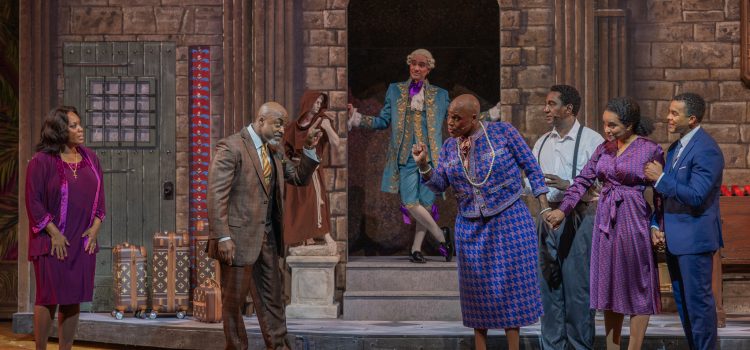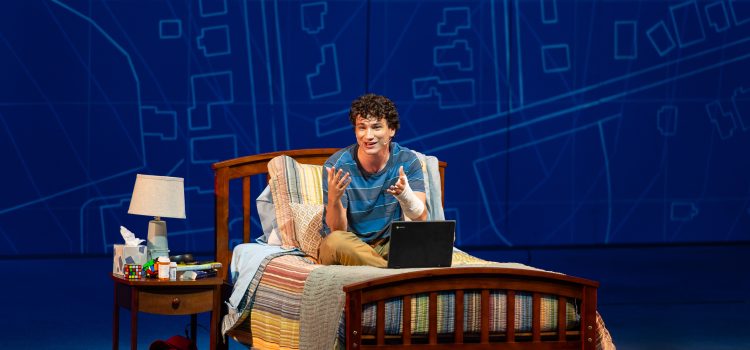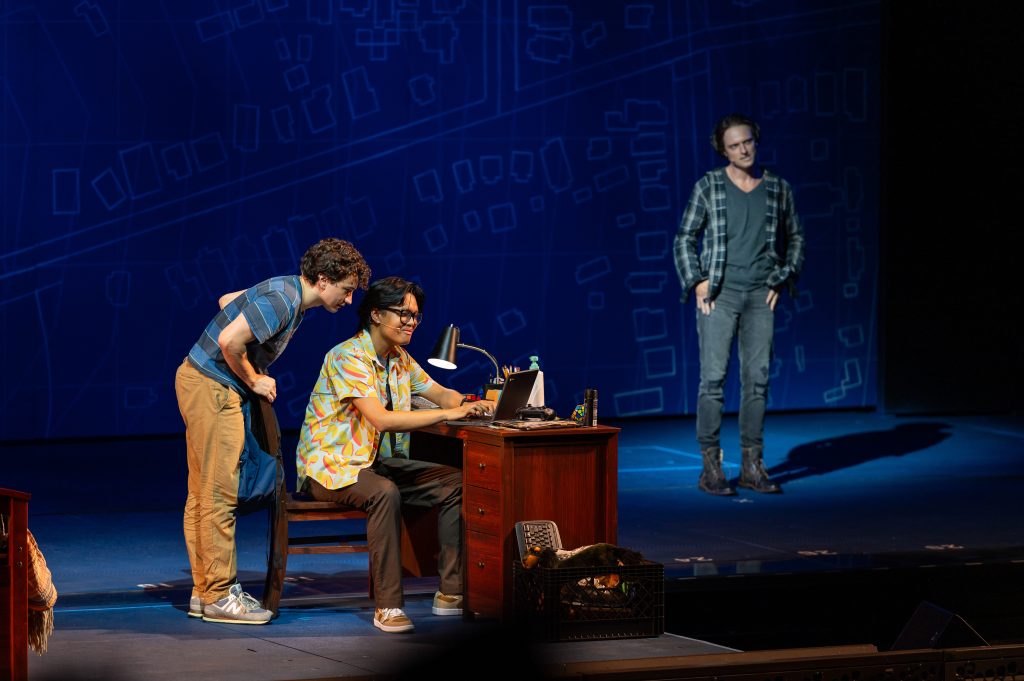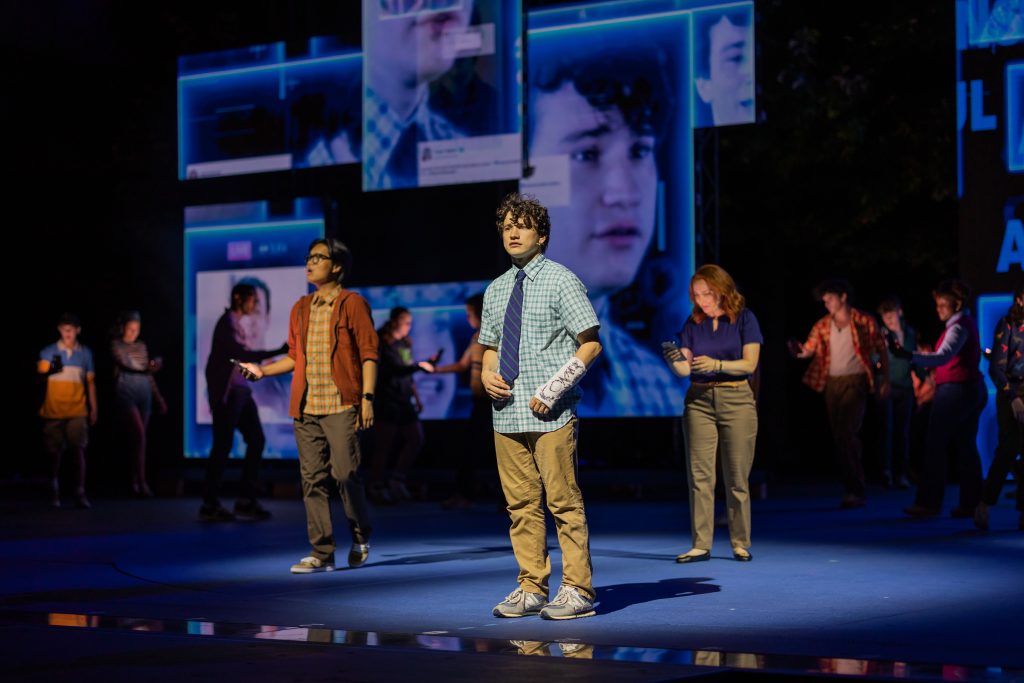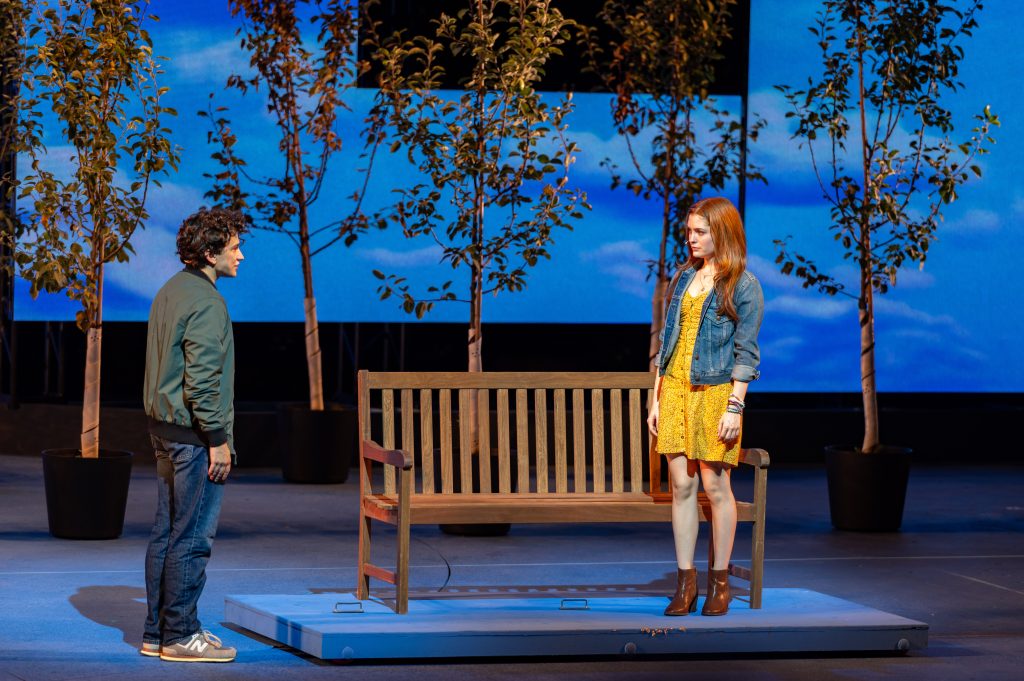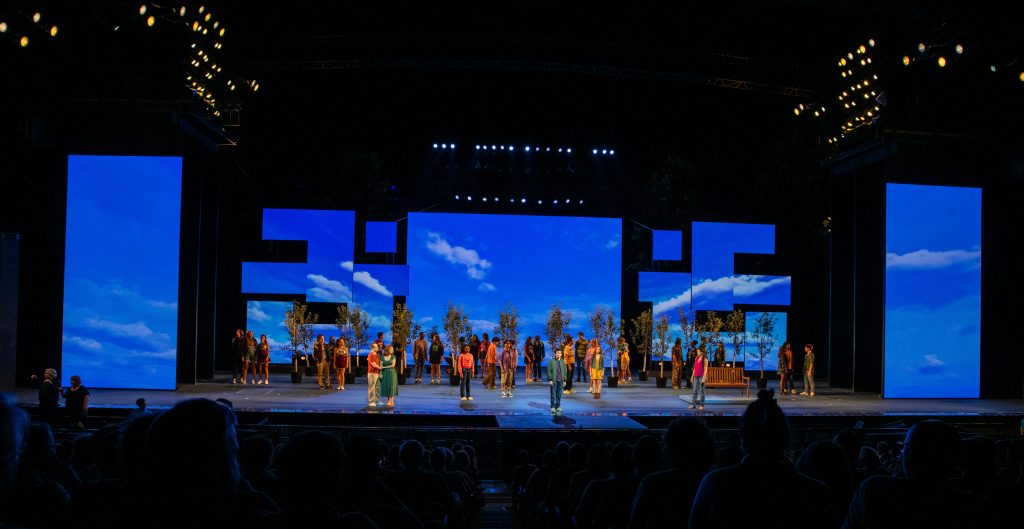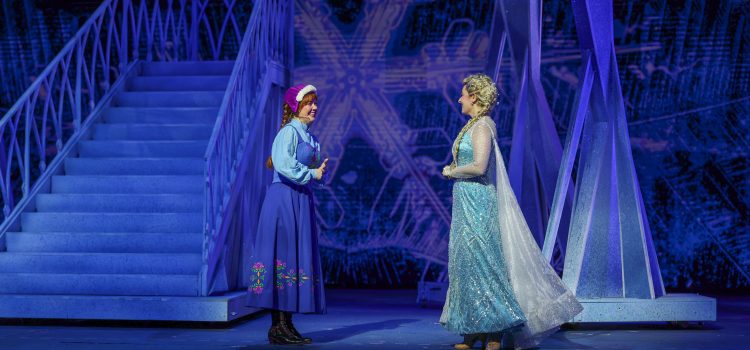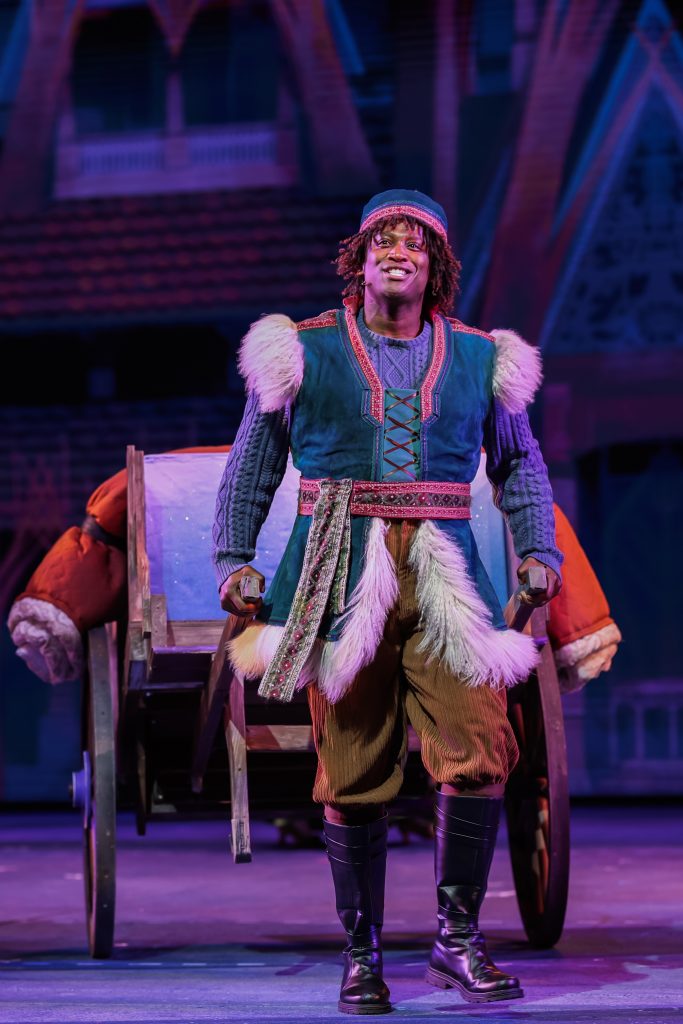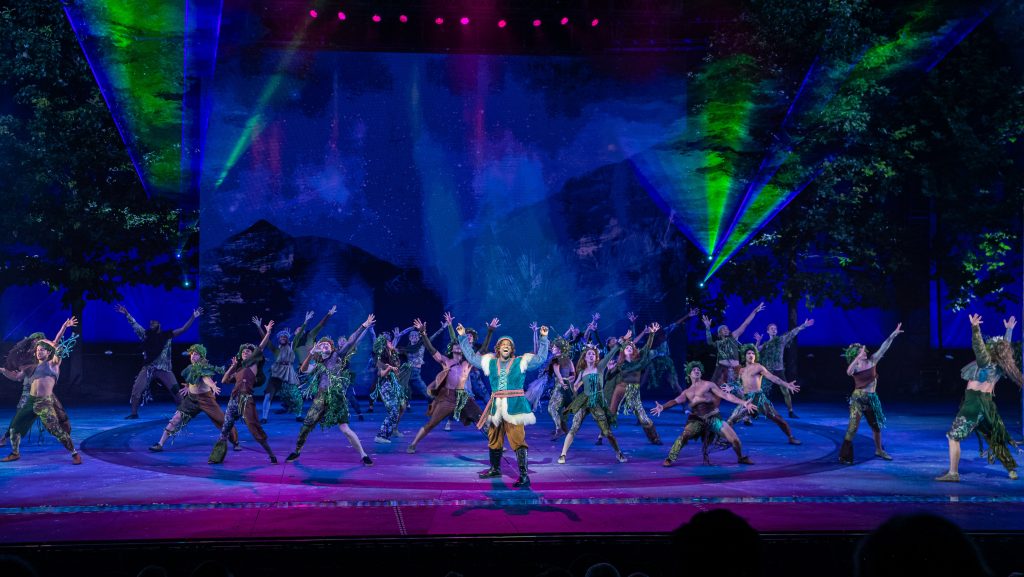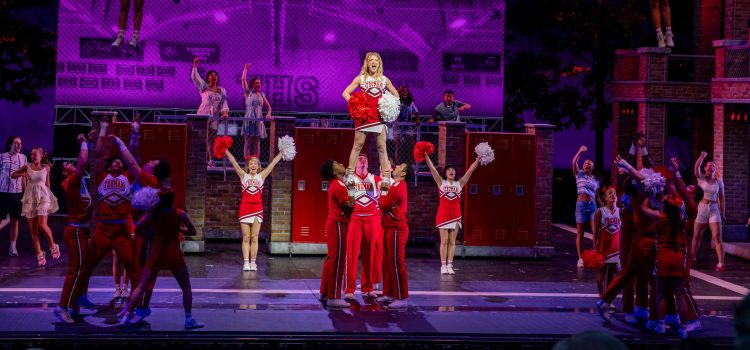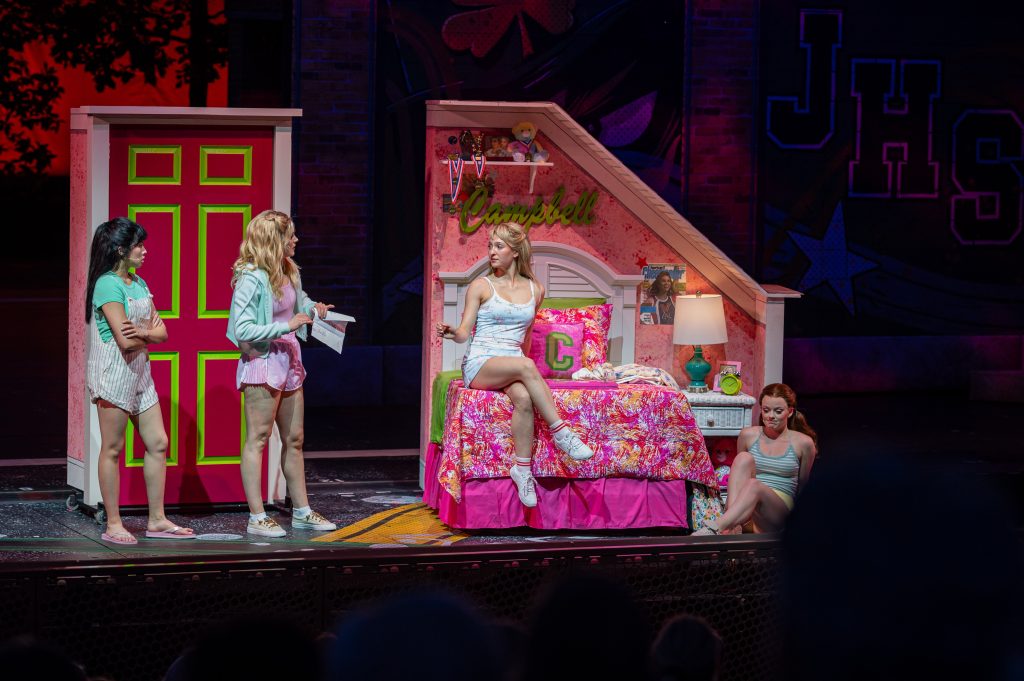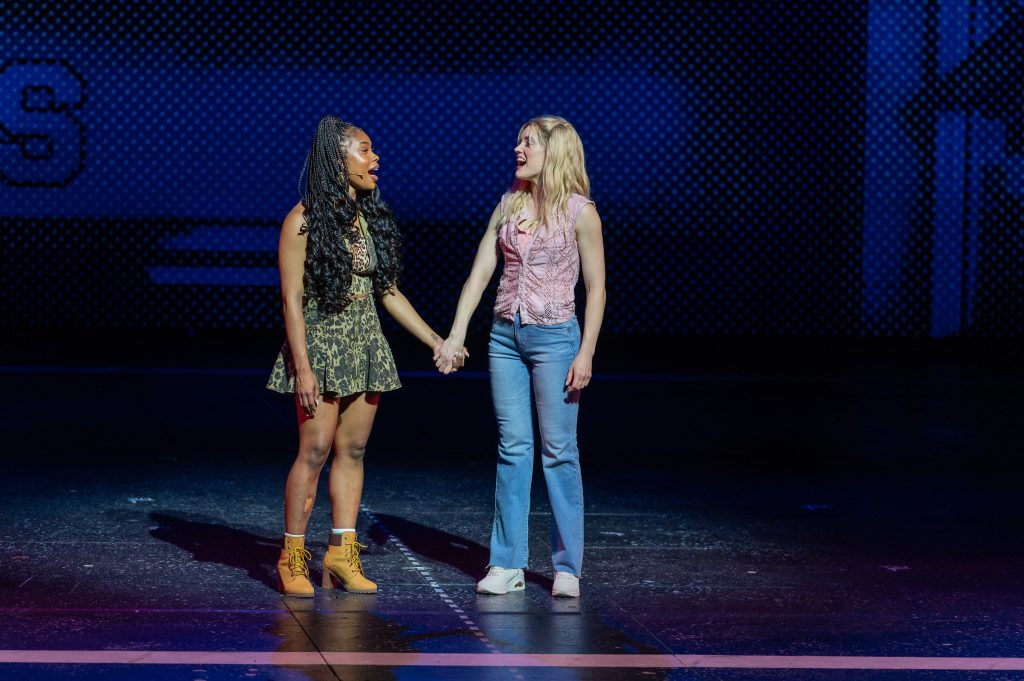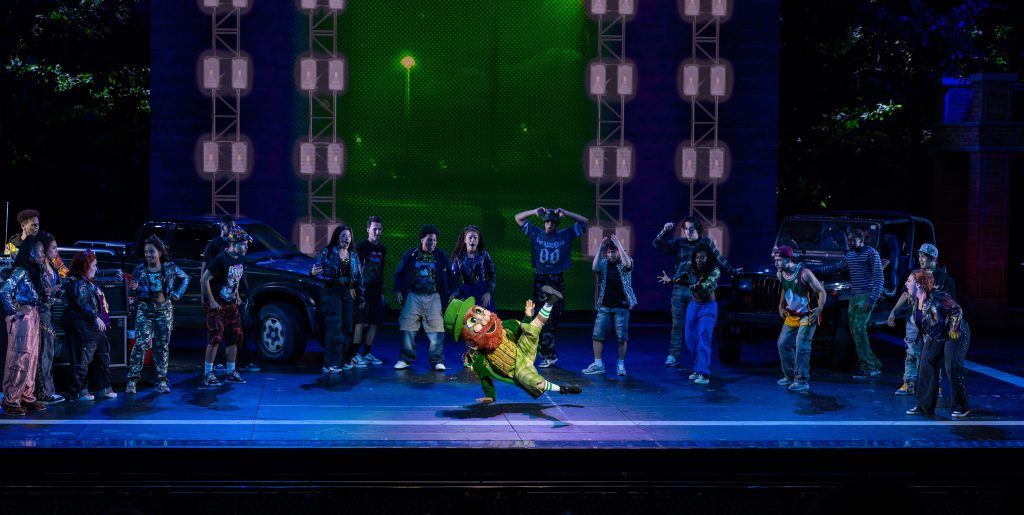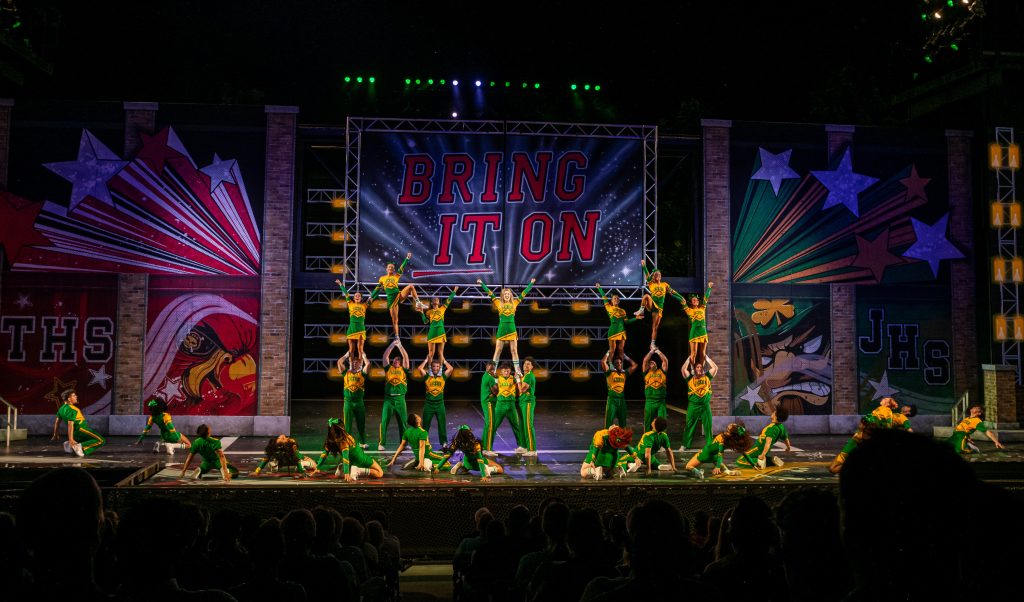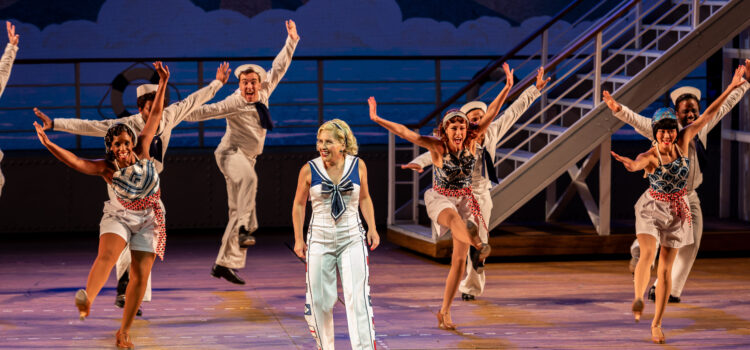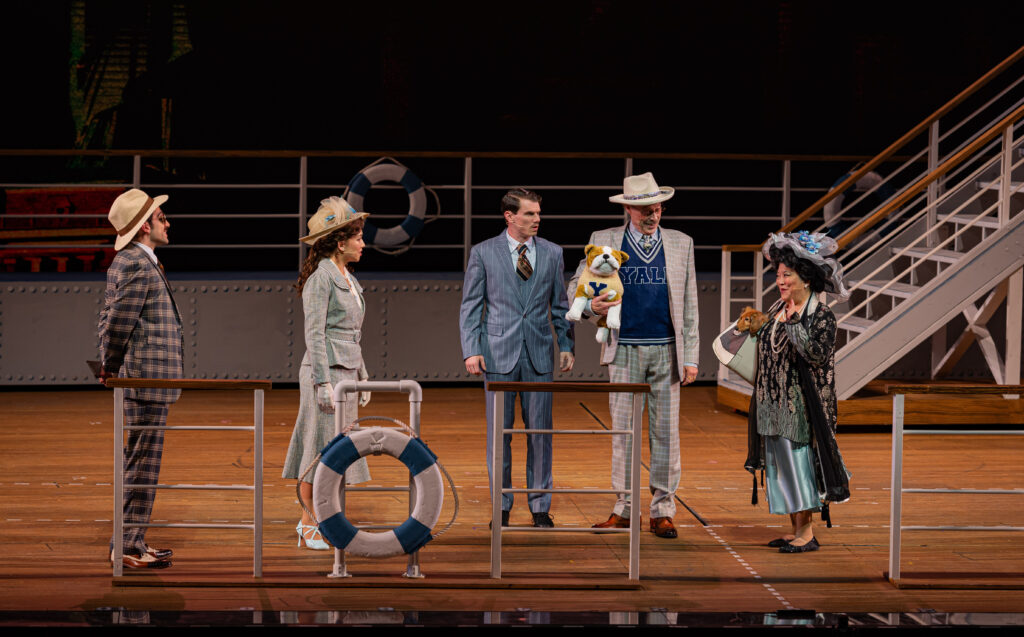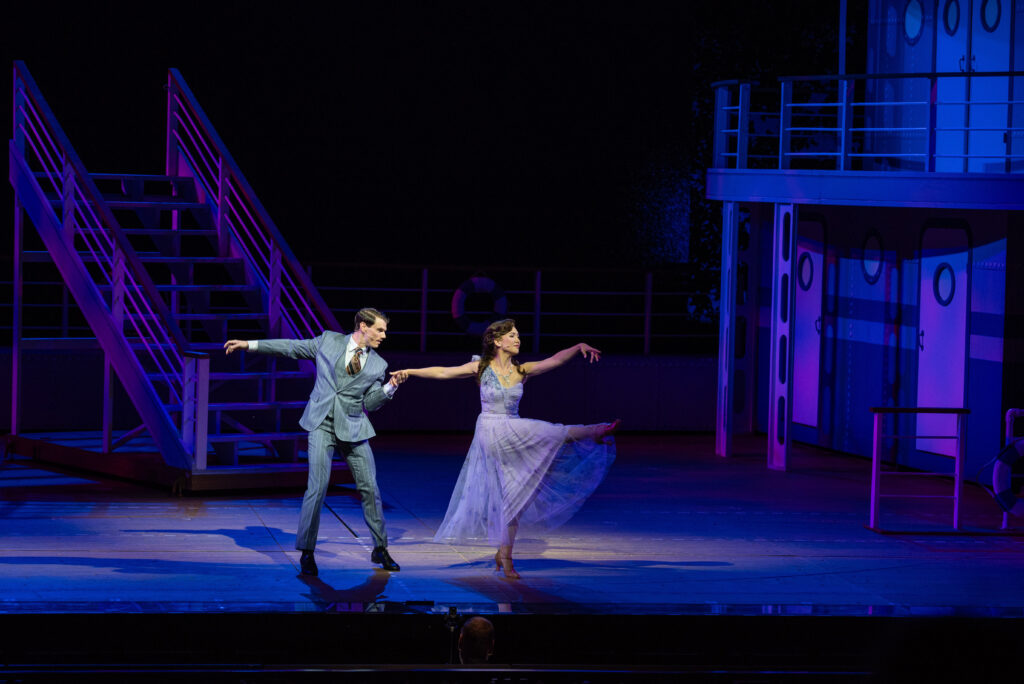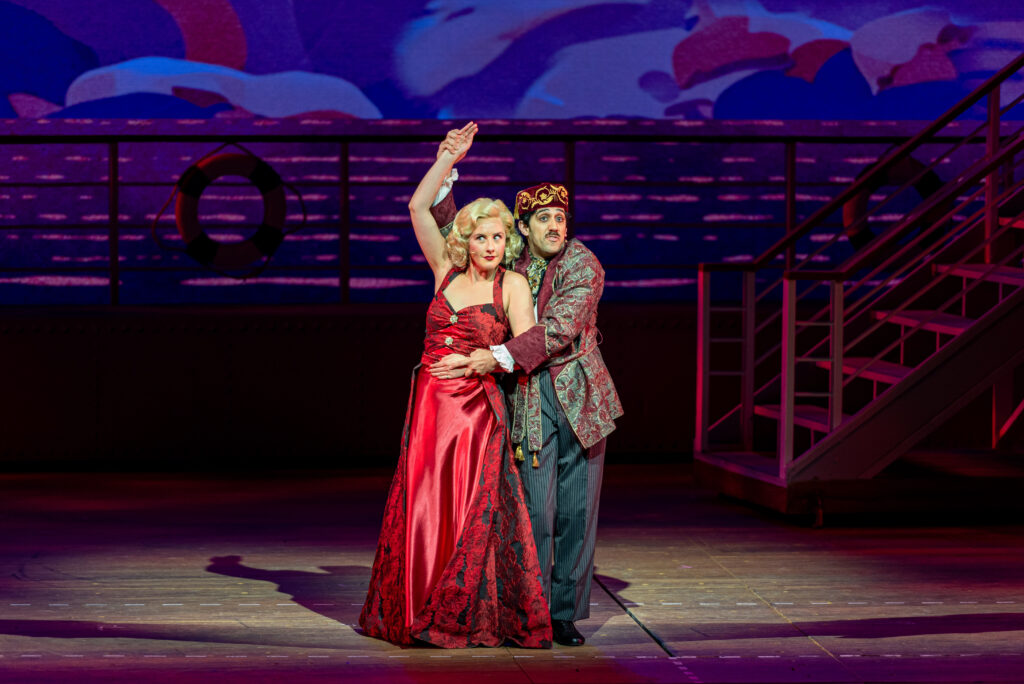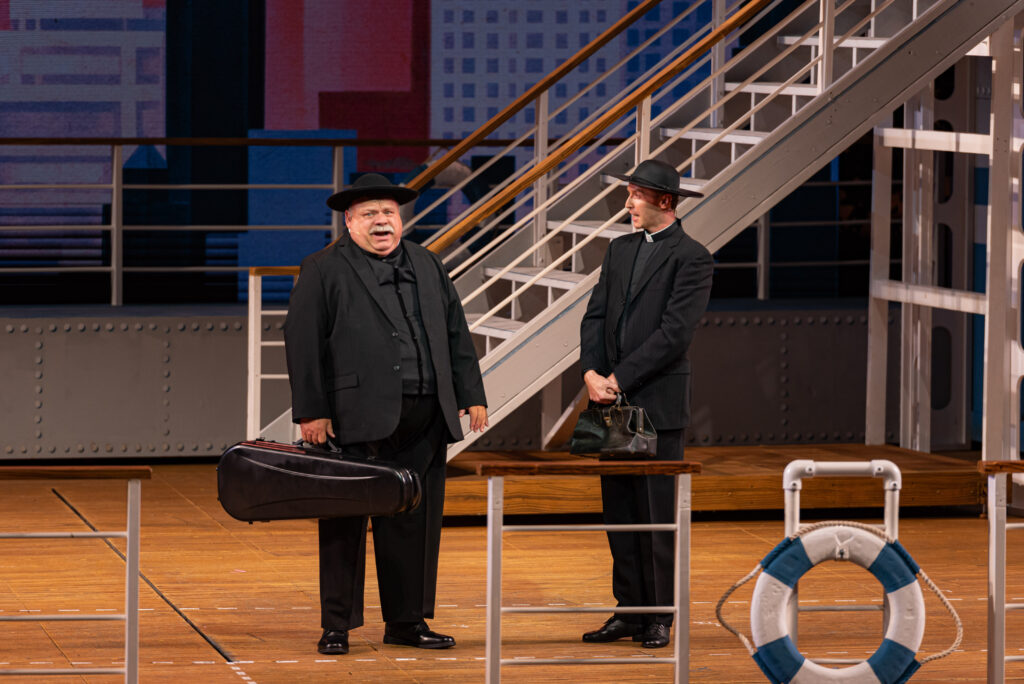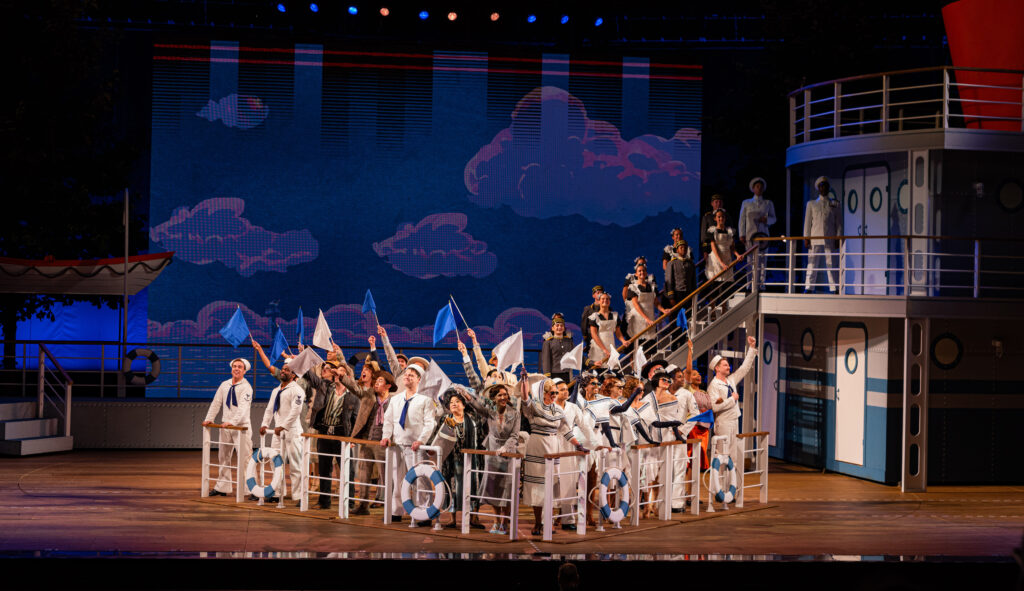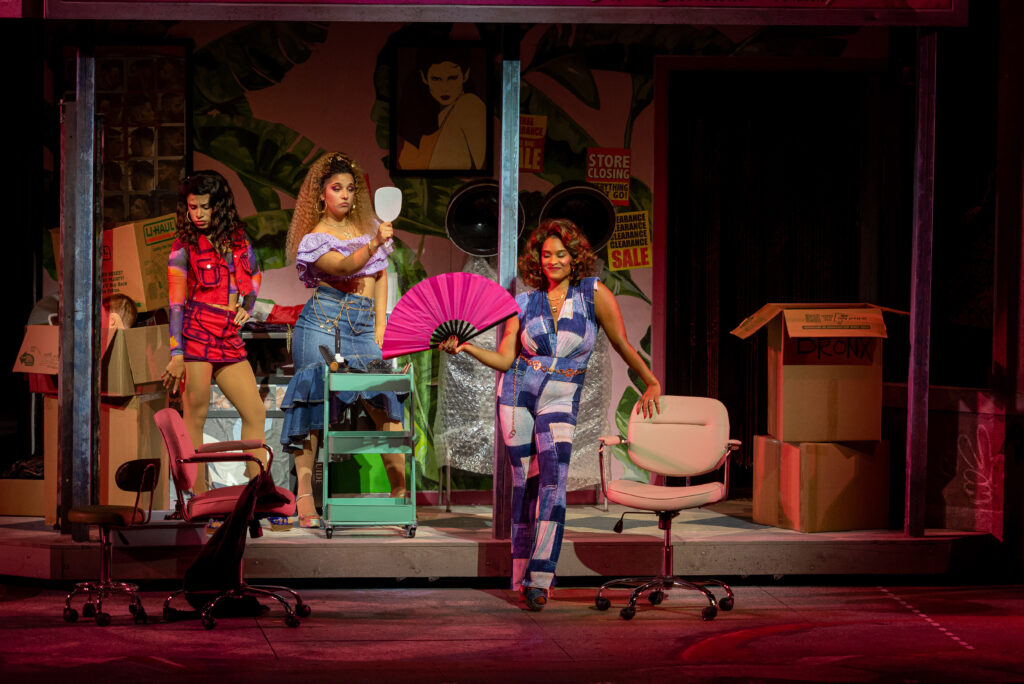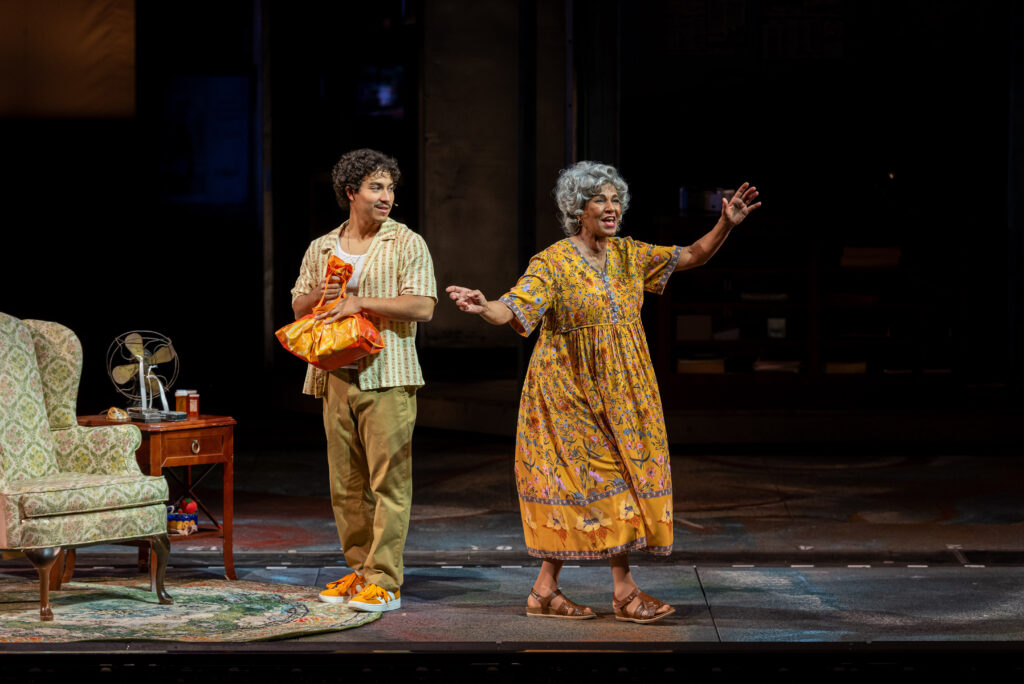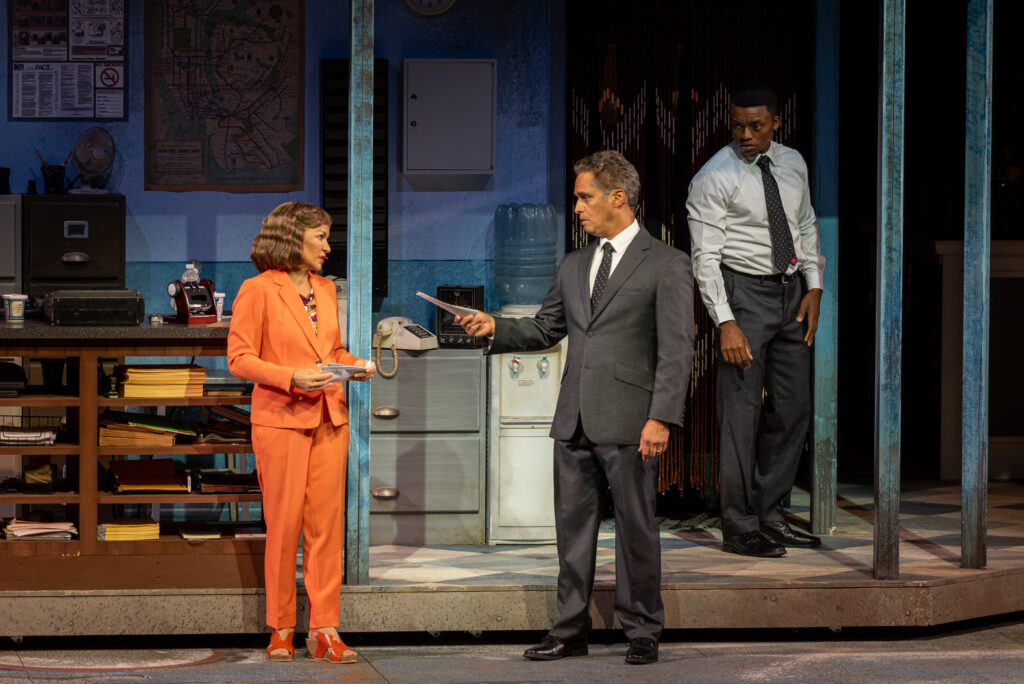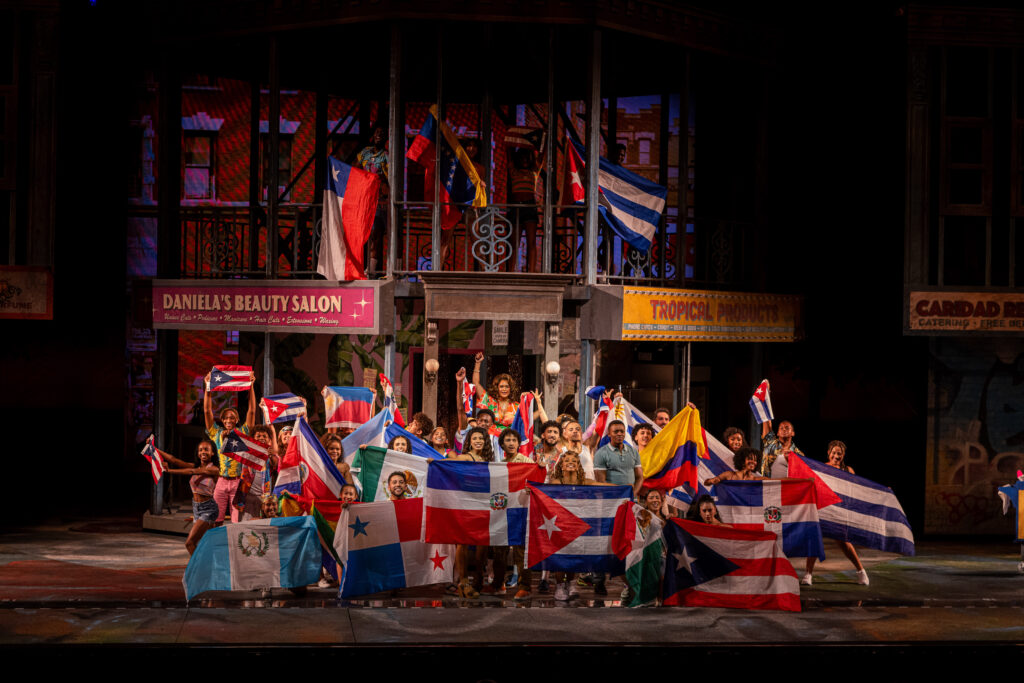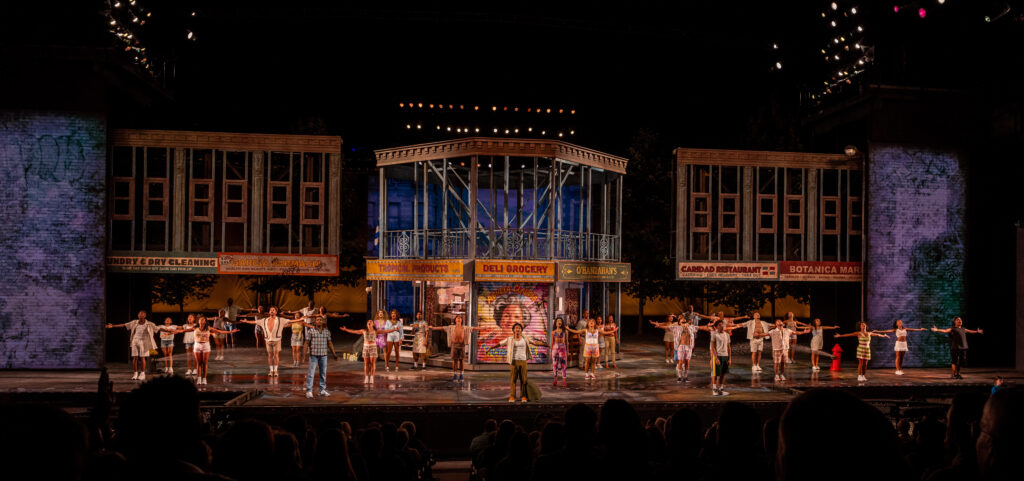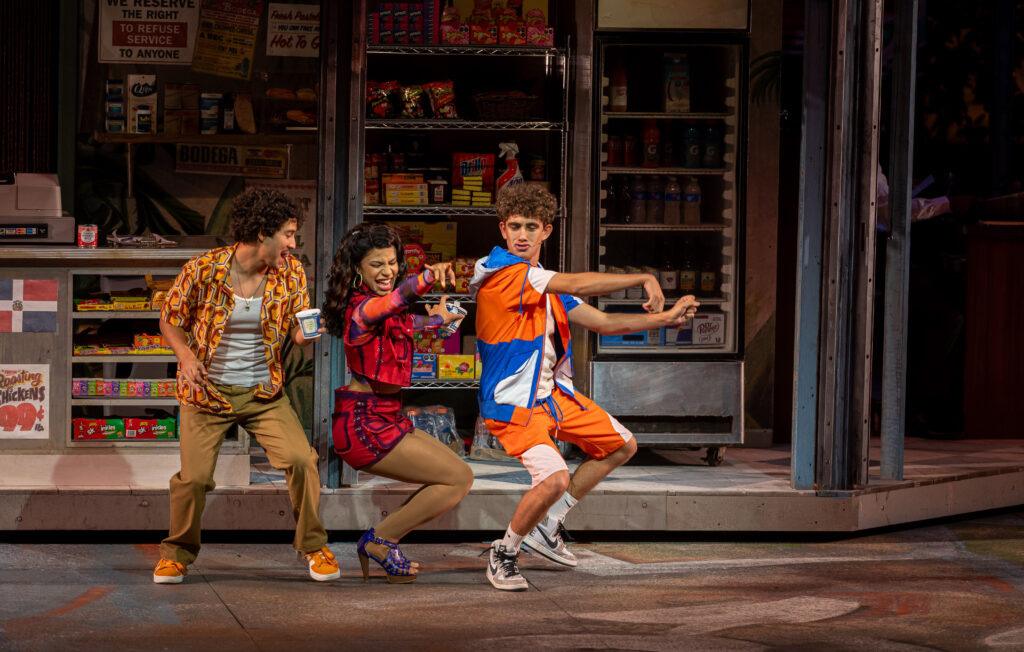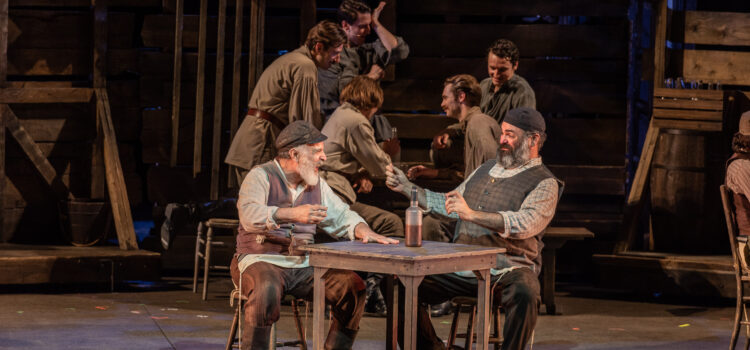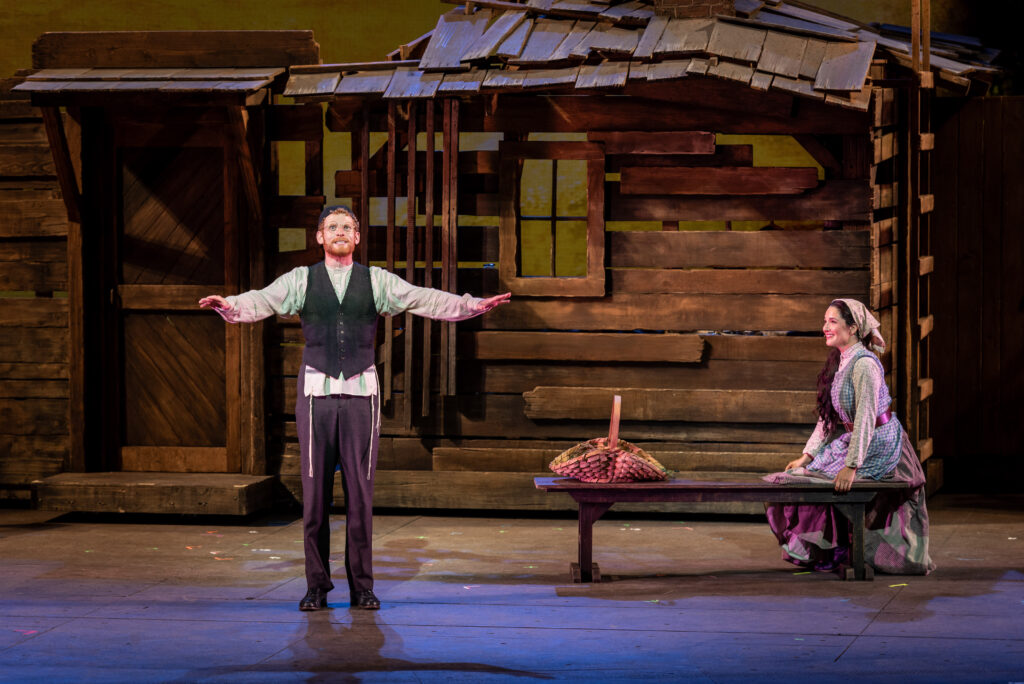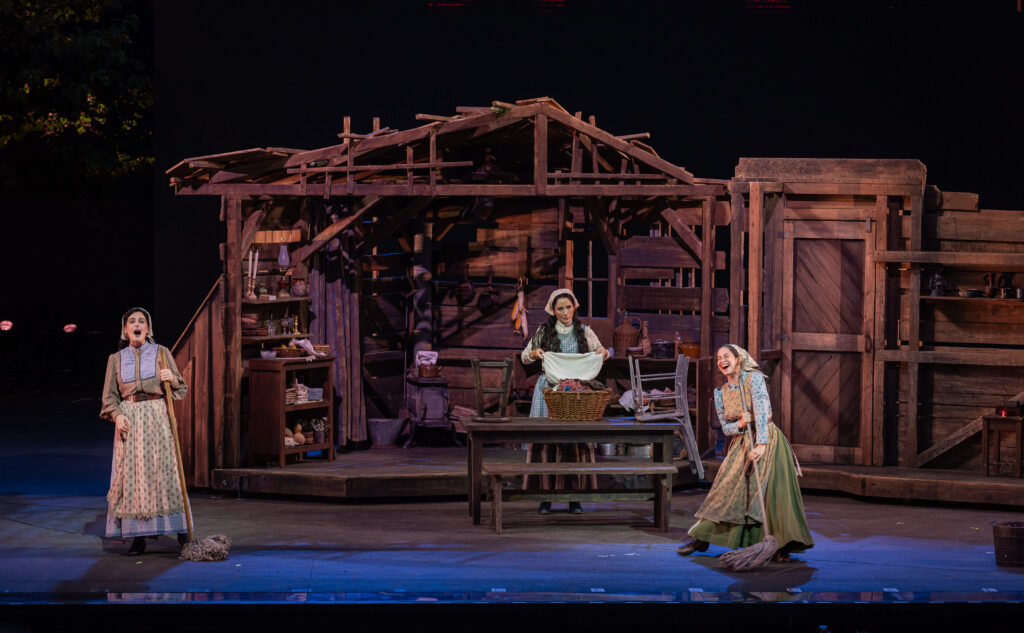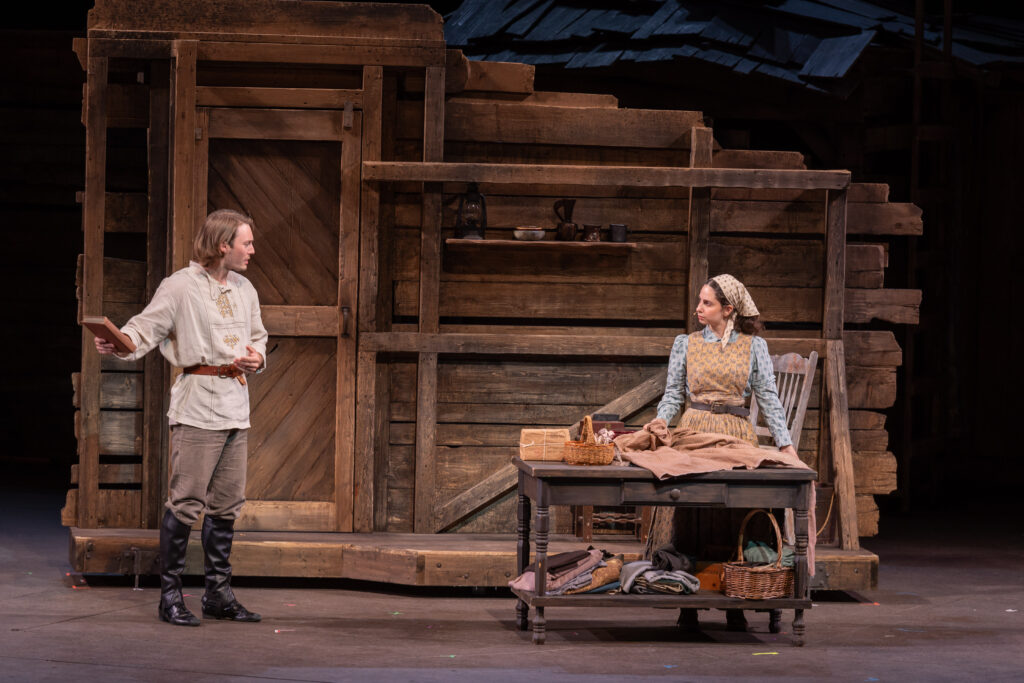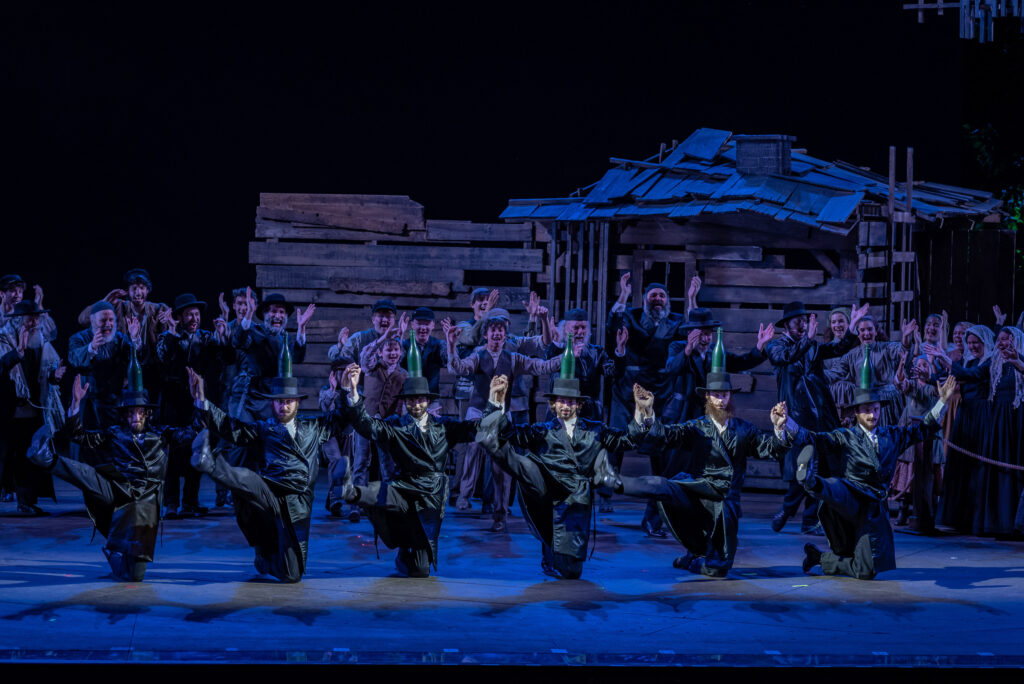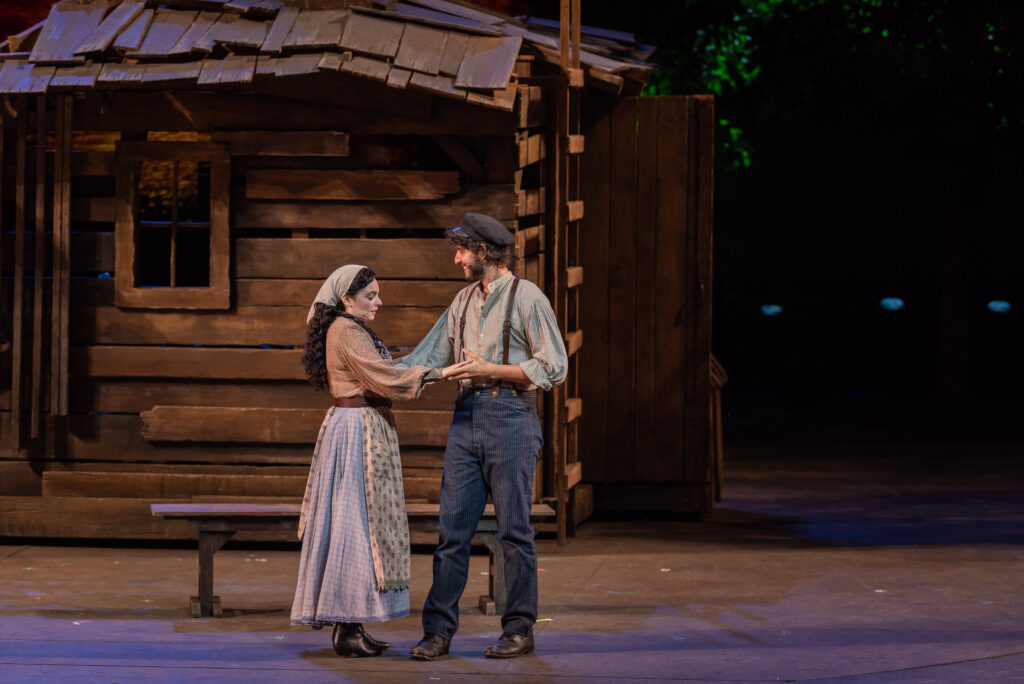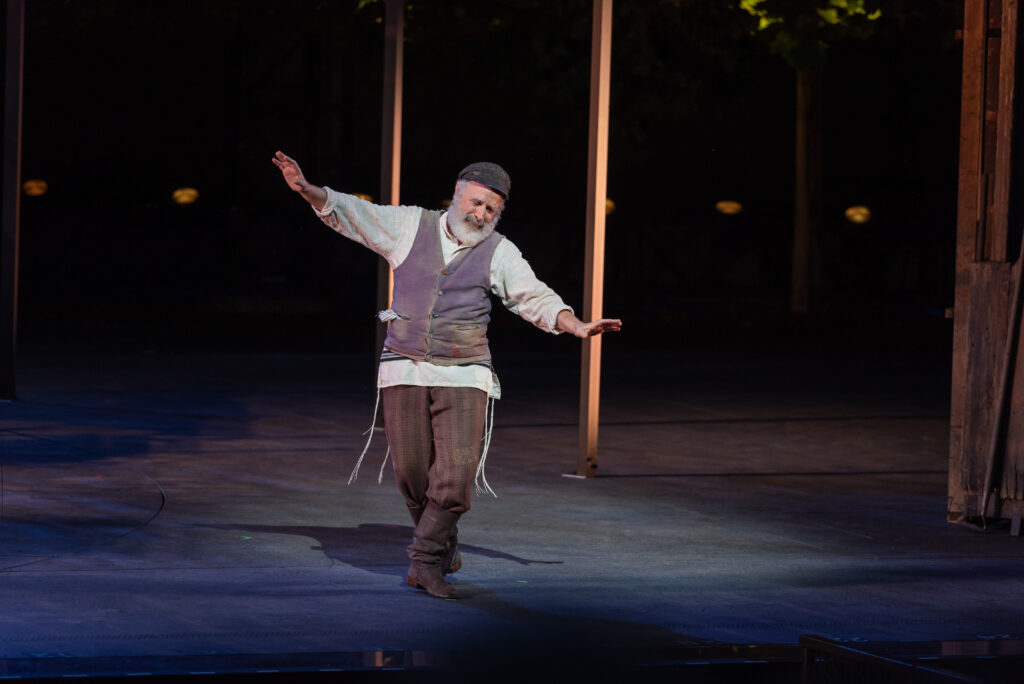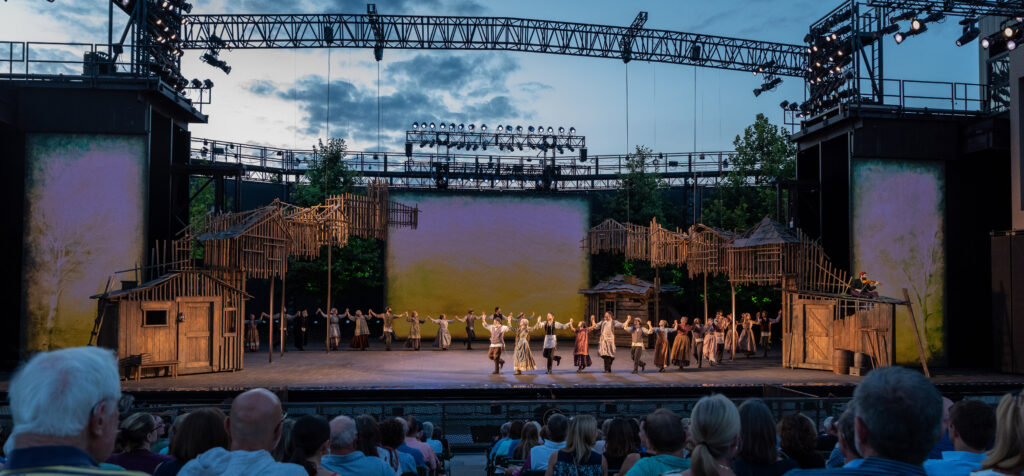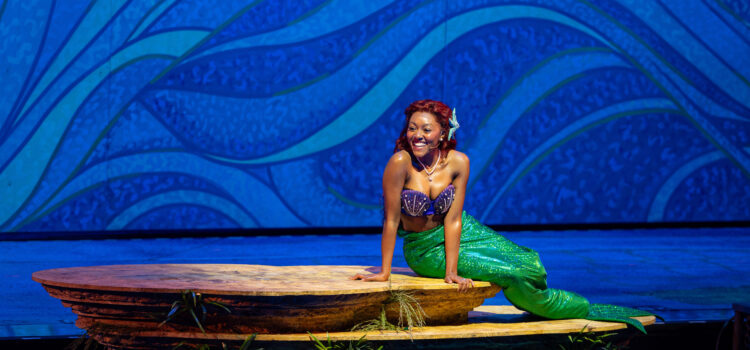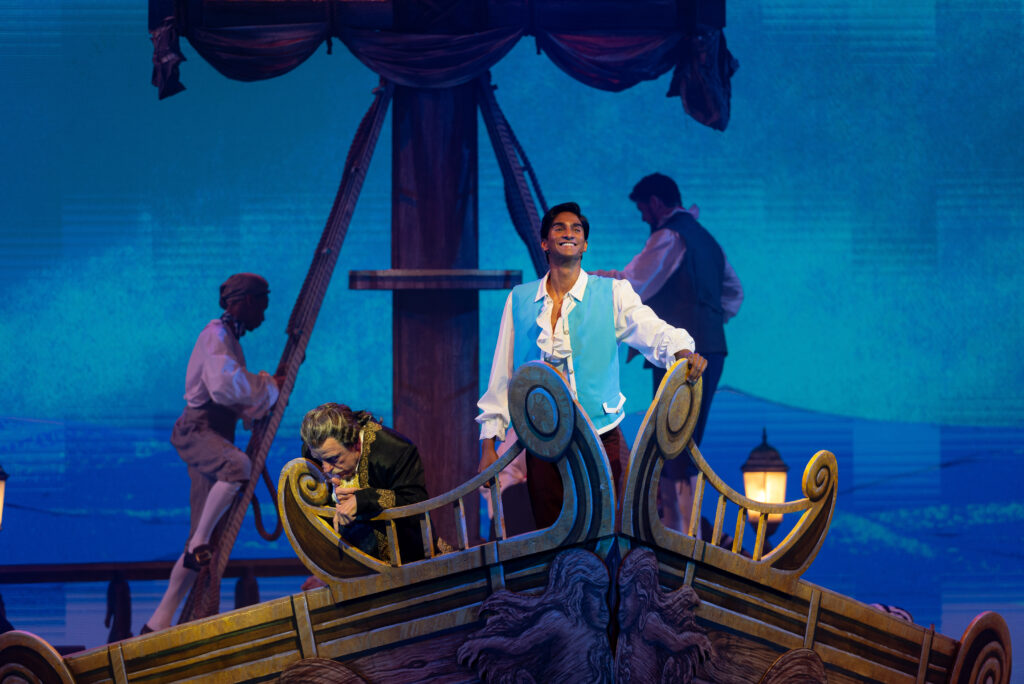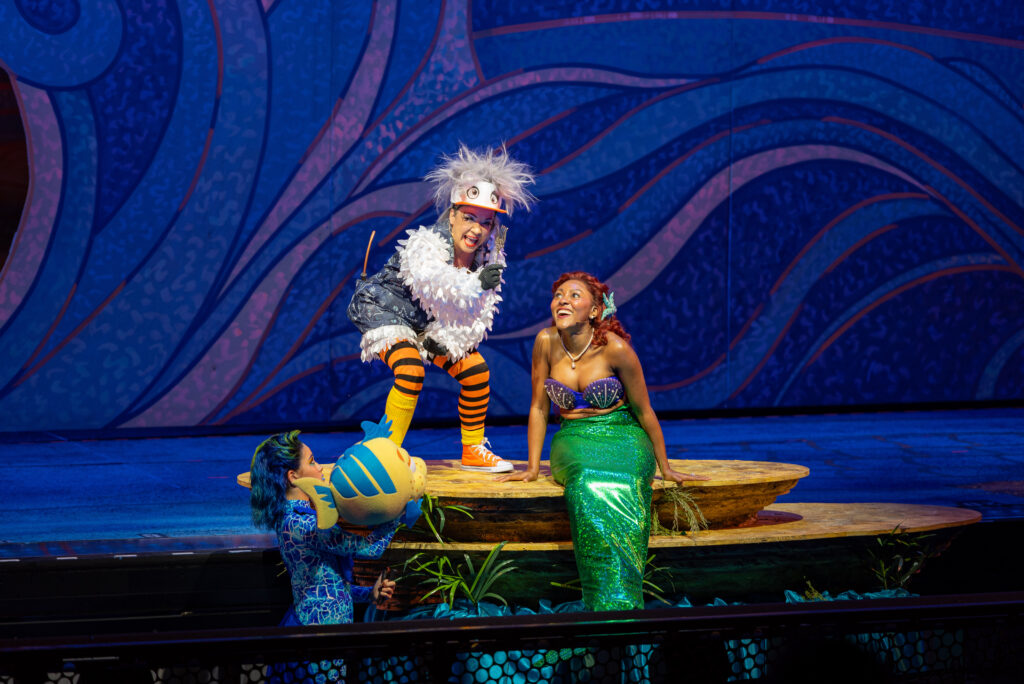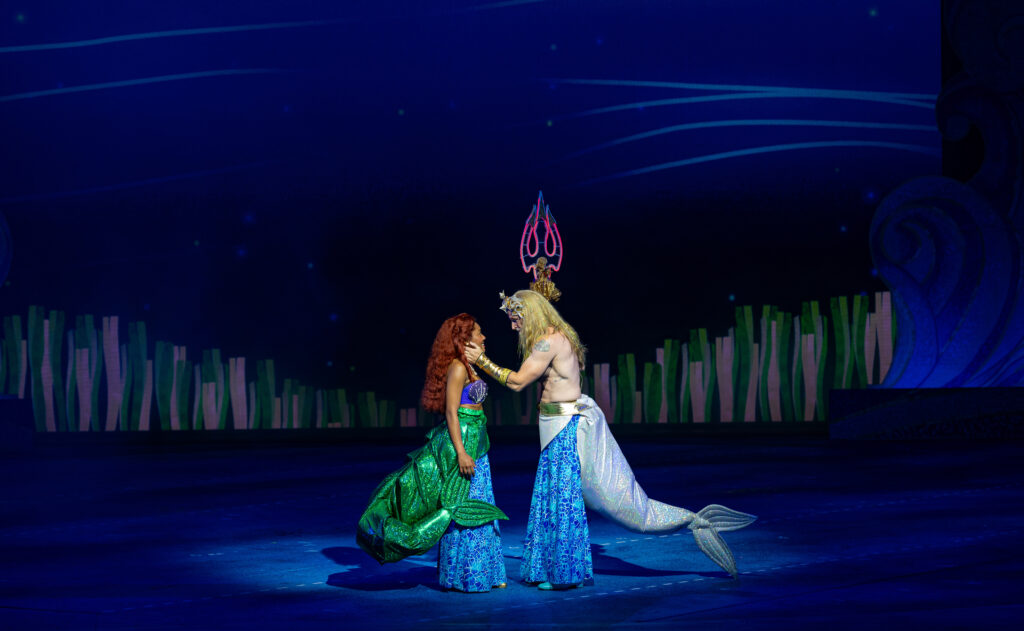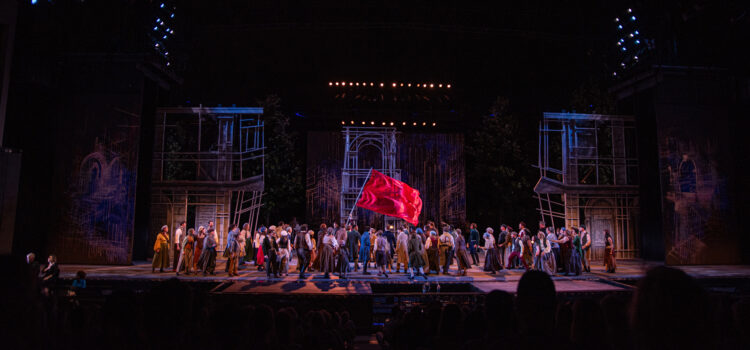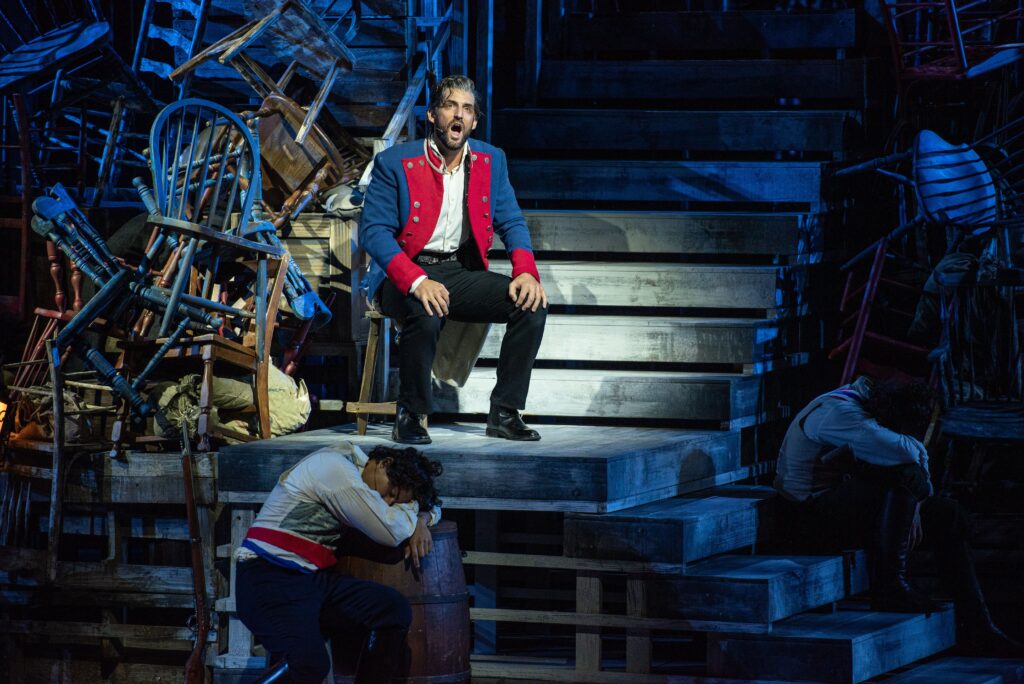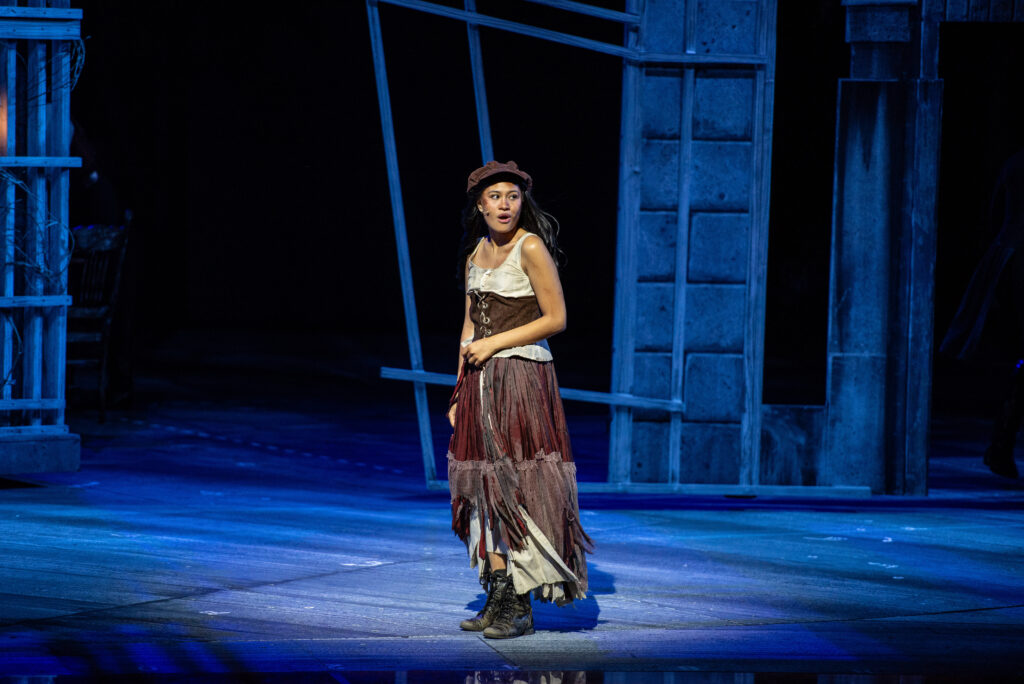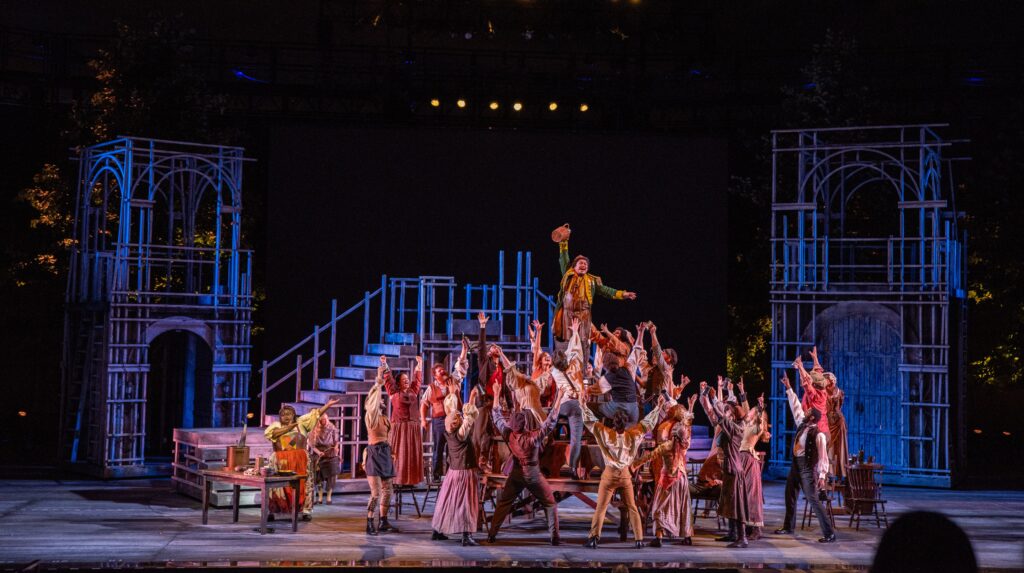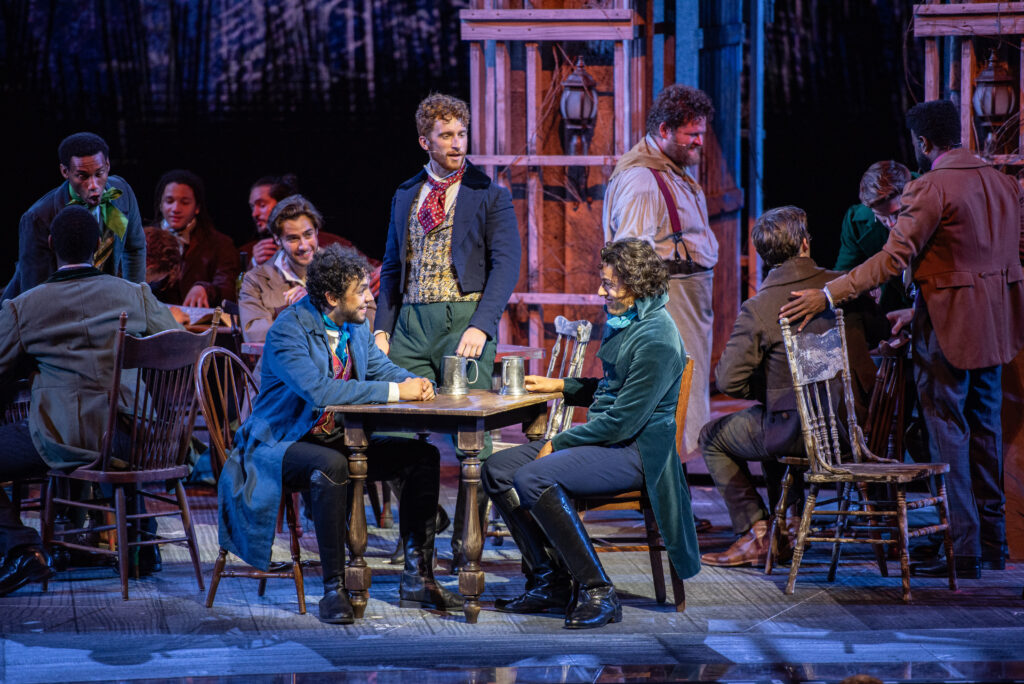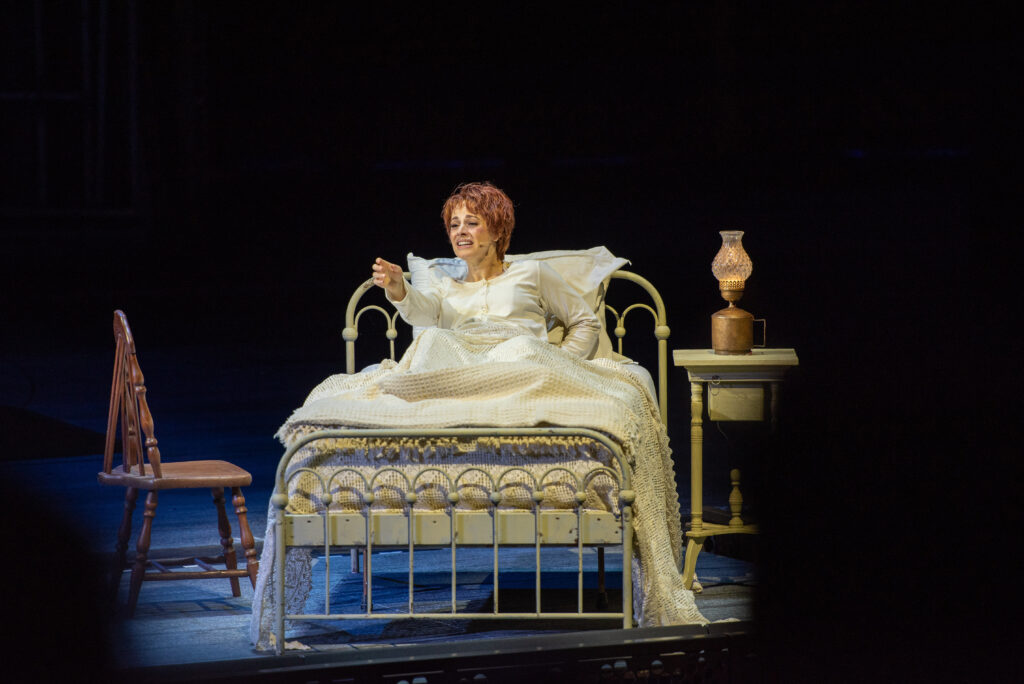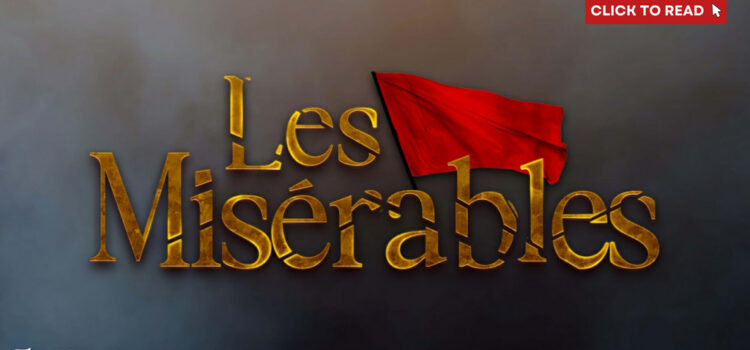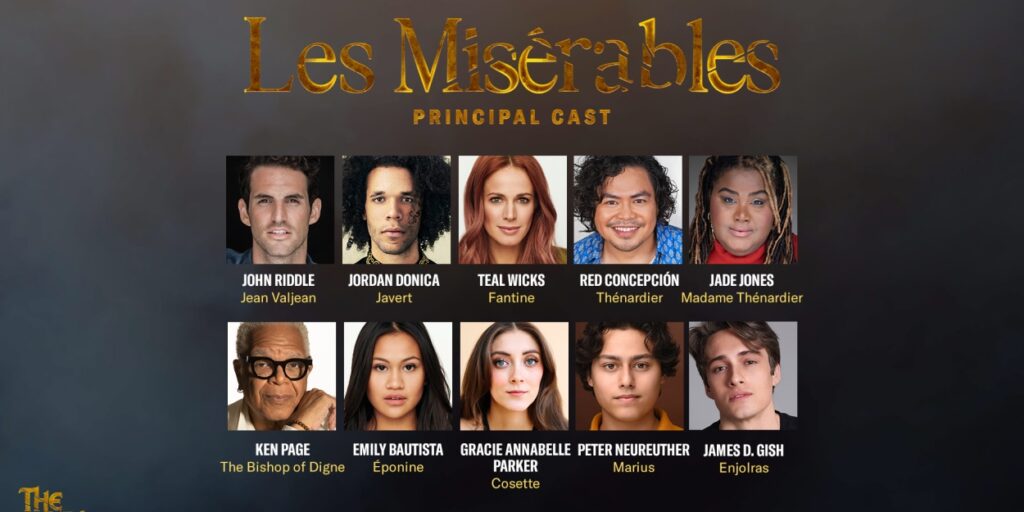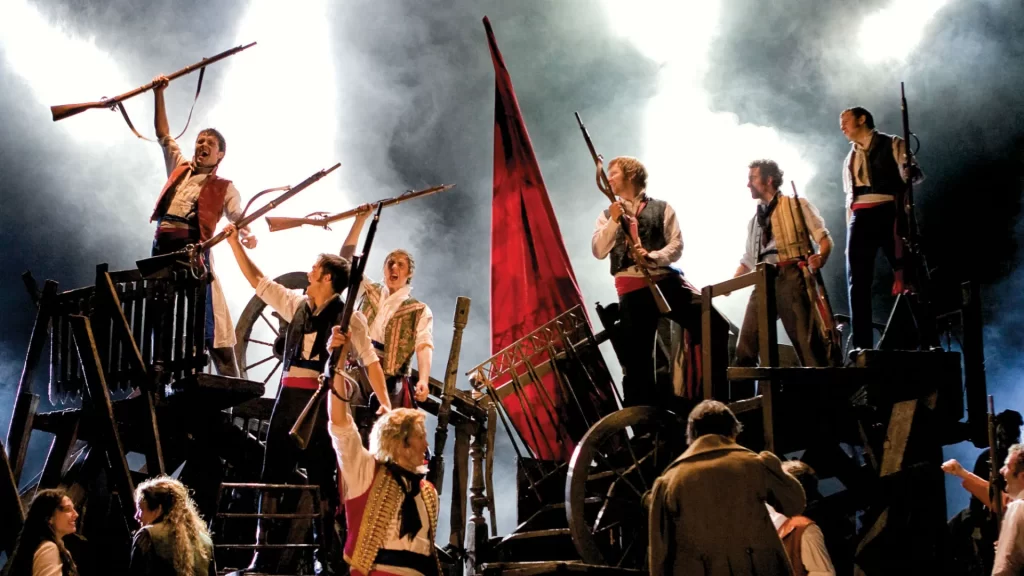By Lynn Venhaus
Release the serotonin! The Muny goes big with the glitzy, grand feel-good musical “La Cage Aux Folles” that will make you laugh, gasp and cheer as you walk away uplifted.
The ensemble’s ebullience was a joy to behold. Bon Voyage as we head for entertaining escapades in Saint-Tropez.
Over-the-top is the intention of this pizzazzy production — a gleaming spectacle overflowing with vibrant energy, a bonhomie spirit, snazzy style, rousing renditions of composer-lyricist Jerry Herman’s optimistic score, all layered with Harvey Fierstein’s sharp farcical humor.
I’m not sure who was having more fun – the actors on stage or the audience. From the opening introduction on, the crowd was eager to be delighted, its mood palpably upbeat.
I was swept away by two of Broadway’s biggest and brightest stars, Norm Lewis as Georges and Michael James Scott as Albin, who make a dynamic duo, their sumptuous vocals soaring into the full-moonlit night. They appeared to be having the best of times.
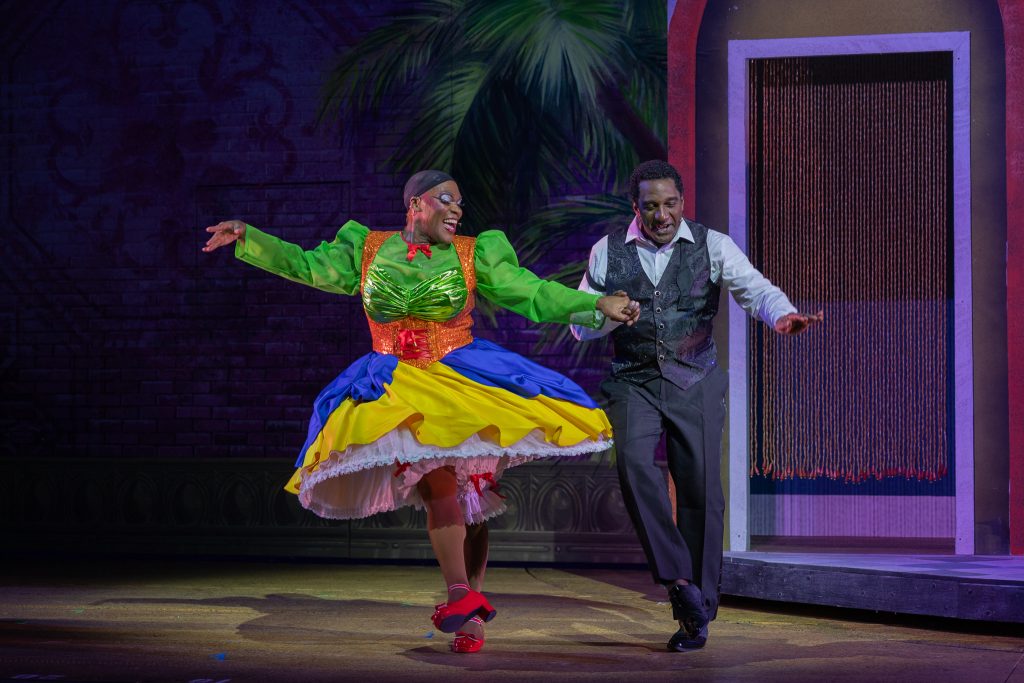
They headline a cohesive cast that’s as committed to excellence as they are – limber in movement, bold and beautiful in appearance, and luminous in song and dance.
Directed with poise and finesse by Marcia Milgrom Dodge, this musical appeals not only in richly textured vocals, but visually with its mélange of Vegas showgirl looks, nods to Moulin Rouge, broad comedy, and dazzling French Riviera setting.
The “Guess Who’s Coming to Dinner?” premise starts with suave Georges, who owns a drag club in the South of France and is in a committed relationship of 20 years with the flamboyant Albin, who is the club’s star drag queen, Zaza.
Georges’ anxious son Jean-Michel (Mason Reeves) pops in for a big favor – he asks that his father pretend to be straight for one night, and his mother figure hidden away, because his fiancé’ Anne (a posh, likable Cameron Anika Hill) has parents that are ultra-conservative. He has invited them to visit.
The priggish future father-in-law Edouard Dindon (Terence Archie) is a well-known right-wing politician opposed to the LGBTQ+ community, and his uptight wife Marie (Allison Blackwell) is all about status. Exposing the same-sex couple could lead to the headline-making shutdown of La Cage Aux Folles (French translation: “The Cage of Madwomen.”)
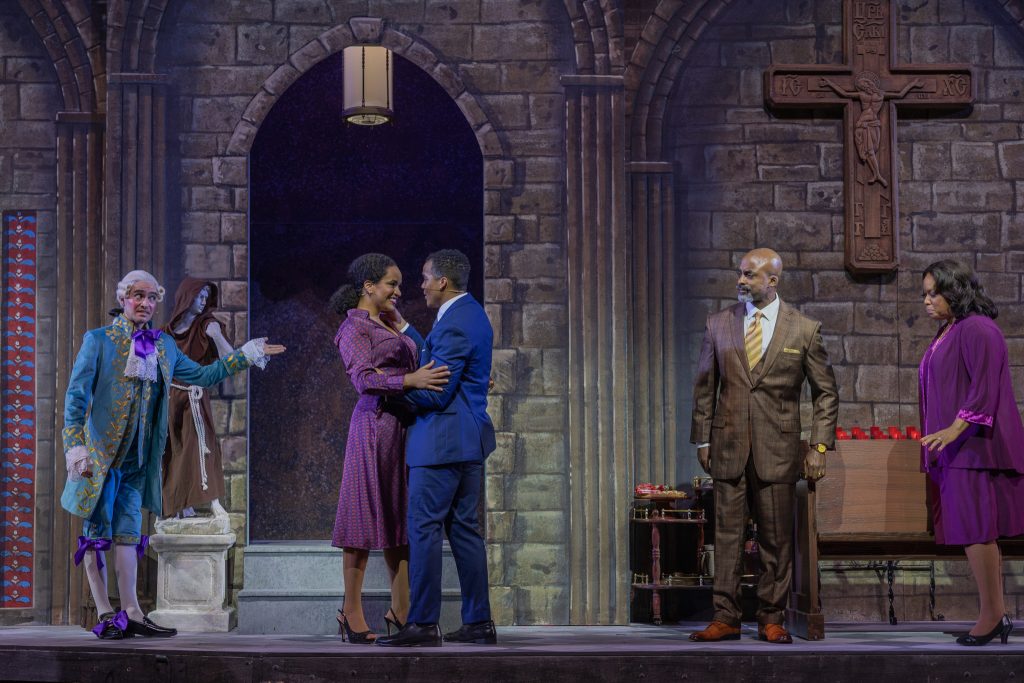
The virtuoso Lewis, who commands any stage with his deep baritone, is silky smooth in his tender solo ballads – the reflective “Song in the Sand” and heart-tugging “Look Over There.” A renowned Broadway veteran, he’s also starred in films, TV and on global stages.
Scott, a graduate of The Conservatory at Webster University who is currently playing the Genie in “Aladdin” on Broadway, is a comedic gem as Albin, radiating theatricality and deep devotion to his family, doting on Jean-Michel.
So, he is hurt by having to pretend he is not gay because he proudly accepts himself. As the initial plan falls apart, he shows he’s willing to compromise, a selfless gesture.
Scott brings down the house with his defiant declaration “I Am What I Am,” a powerfully sung anthem that closes Act One with a flourish. The ovation was deafening.
In another signature song, “The Best of Times,” he solos and leads the group in a sing-along that expands from the actors to the audience, about living happily in the present, a catchy, melodic tune with hopeful meaning that closes the show.
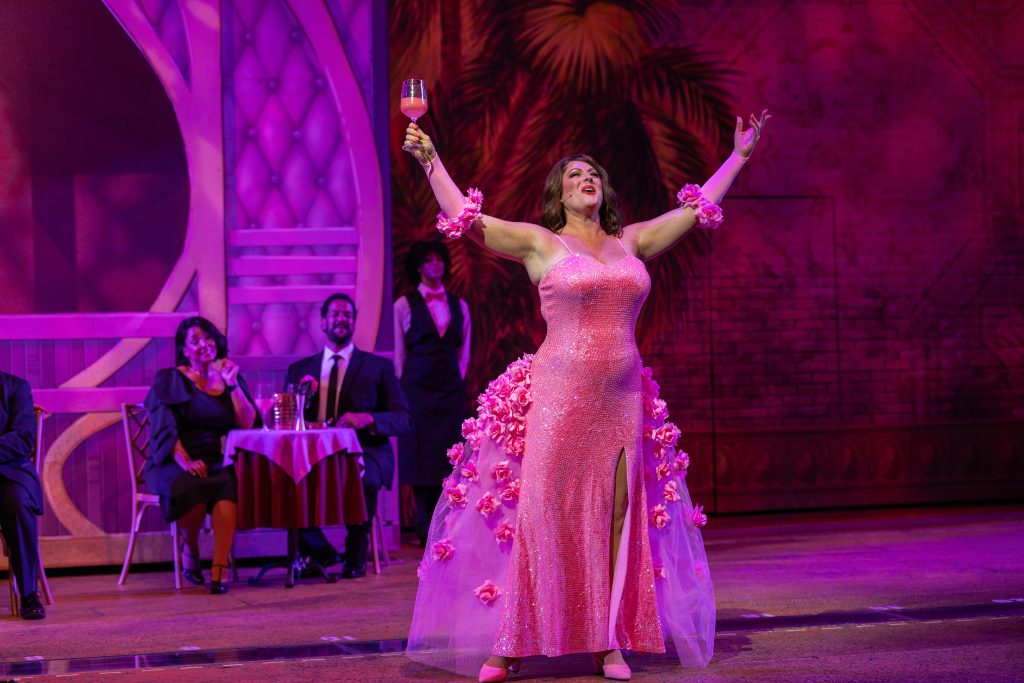
Nevertheless, chaos escalates, and hilarity ensues. No matter how many times I’ve seen the movies or the musical gales of laughter are unleashed, and this time was no exception.
The “Masculinity” sight-gag number where Albin tries to act macho, as coached by Georges, is side-splitting, and as the charade eventually collapses in precise physical comedy “Dishes (Cocktail Counterpoint)” provides more belly laughs.
Herman, the legendary composer behind “Hello, Dolly!” and “Mame,” wrote songs that combined humor and heartfelt emotions.
The show features sweet and sentimental moments, with passionate emphasis on acceptance, people trying to hold on to their dignity while others would like to strip it away, and what it means to be a family.
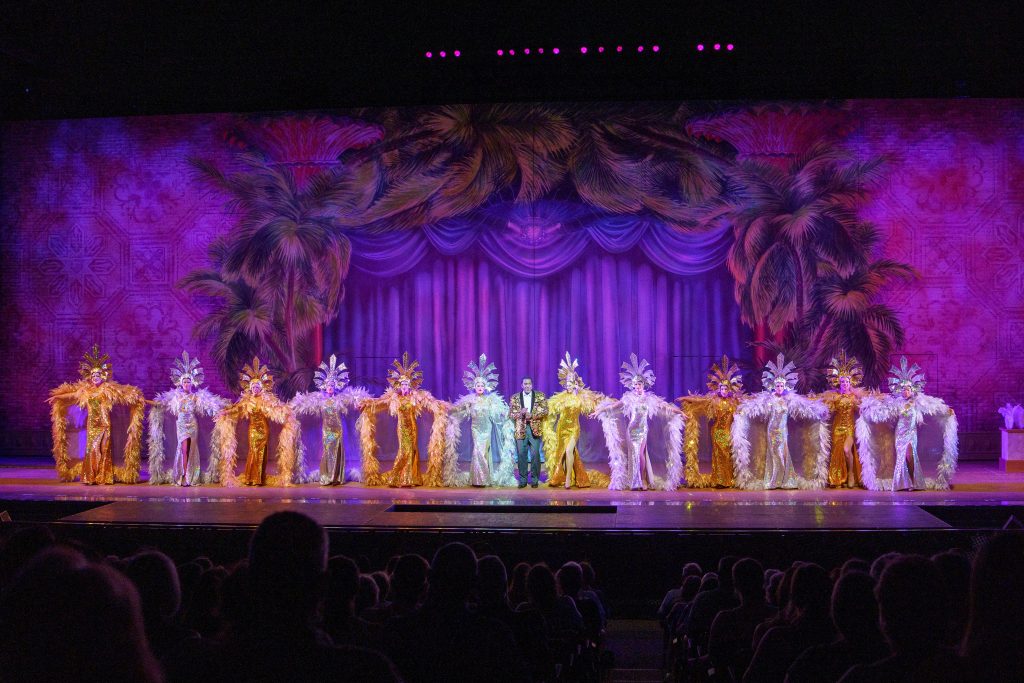
At first sight, I fell in love with the original 1978 French film “La Cage aux Folles,” which was adapted from the same-titled farce by Jean Poiret in 1973. So, when director Mike Nichols teamed up with his old comedy partner Elaine May for a 1996 American remake starring Robin Williams and Nathan Lane, they struck comedic gold with “The Birdcage.” The beloved film has made nearly $200 million at the box office.
The lavish Broadway musical first appeared in 1983, ran for 1,761 performances over more than four years, and was nominated for nine Tony Awards, winning six. It also won for its bigger, bolder revivals in 2004 and 2010.
The Muny premiered the larger-than-life romp in 1986, and now, 39 years later, it’s back with the elaborate splash the largest outdoor theater masters so well.
For her 10th Muny show, Dodge, who imbued a vintage vaudeville vibe to her “Anything Goes” production last summer, leans into the comic calamities in Fierstein’s script, and benefits from a game supporting cast with slapstick expertise.
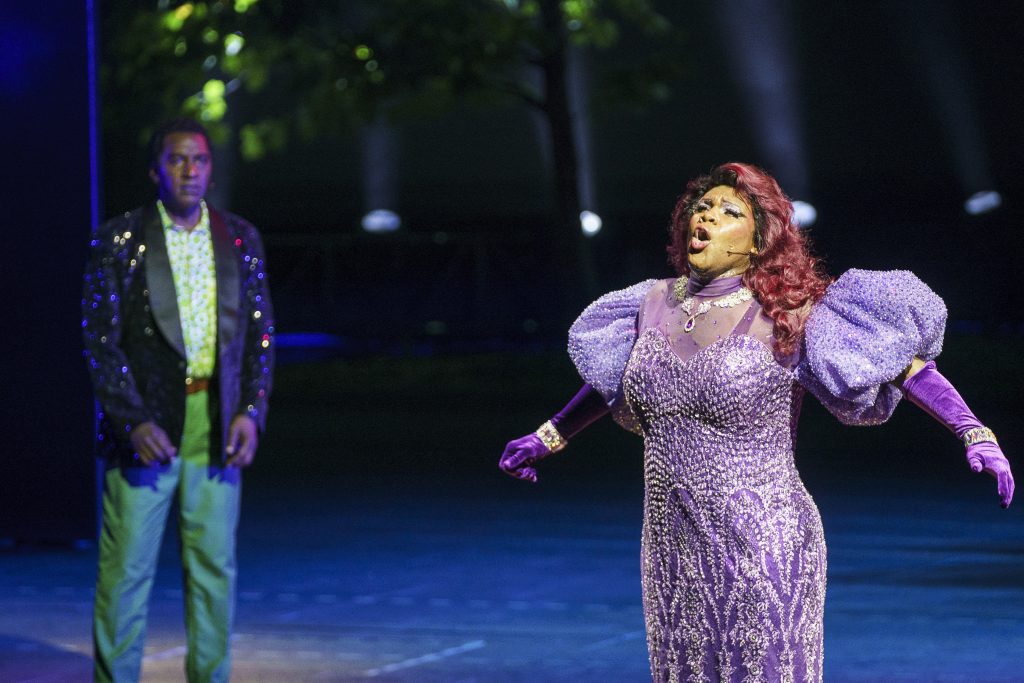
Troy Iwata, a scene stealer as clog-dancing Ogie in last summer’s “Waitress,” again stops the show with his laugh-out-loud hijinks as Jacob, the couple’s temperamental butler who identifies as the maid. His physical comedy, particularly with the guests’ luggage, combined with his zesty one-liners, are highlights.
Also adept at crisp comic timing is Michael Hartung, who is the nightclub stage manager Francis. This is his 12th Muny show.
In her Muny debut, vivacious Meghan Murphy is chic restaurateur Jacqueline, working the sequins, and providing a solution for a potential scandal. Also making their Muny debuts are the pair playing the pompous Dindons, and Archie and Blackwell dive into their characters’ transformations with glee.
The sparkling ensemble features Leah Berry, Patrick Blindauer, Michael Di Leo, Kylie Edwards, Julia Feeley, Aaron Graham, Cory Hammond, Owen Kent Ing, Madison Johnson, Brian Liebson, Michael Milkanin, Kaylee Olson, Vincent Ortega, Gordon Semeatu, Duncan B. Smith, Cooper Stanton, Kodiak Thompson, YaYa Vargas, Kyle White, Jonah D. Winston –that includes the sensational Les Cagelles, along with the Teen Ensemble Jayden Jones, Keira Leung, Adaeze Loynd, and Jack Mullen.
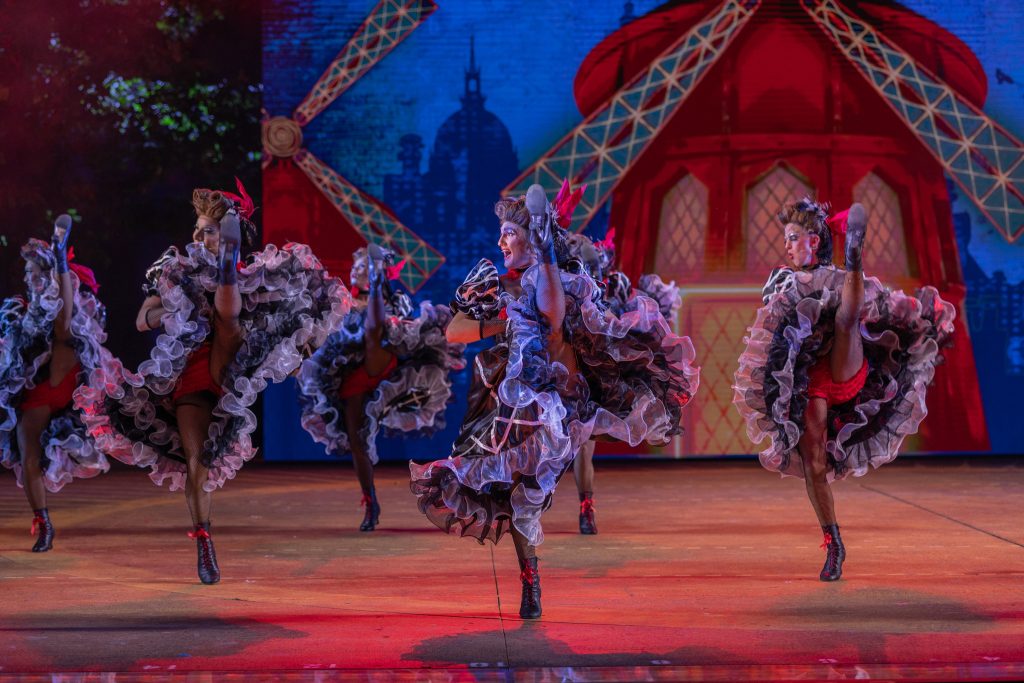
Richard J. Hinds’ inspiring choreography is the cherries on top of a banana split, with flashy promenades and an eye-popping can-can. The dozen “Les Cagelles” are the super-deluxe gender-bending showstoppers – in their rainbow-hued extravagant costumes and glittering headdresses designed by Bobby Pearce, who evidently knows how to make an entrance.
Their looks were enhanced by Tommy Kurzman’s wig designs and makeup designer Heather Aurora Hardin’s bright palette choices.
Music Director Darryl Archibald elegantly conducted the largest Muny orchestra of the season, and their lush sounds captured the score’s emotional resonance as well as its optimistic fervor. Jim Tyler is credited with the orchestrations, and Don Pippin supervised music and arranged vocals. G Harrell arranged dance music.
The stellar creative team collaborated on a 42-year-old show that could be considered an old-fashioned traditional musical – but its freshness and lively interpretation is everlasting. Matthew Buttrey’s scenic design featured ornate risque décor and an austere church-like atmosphere for deep contrasts, while Jason Lyons’ colorful lighting design added glamour, and Kylee Loera and Greg Emetaz video designs filled in locale flavor
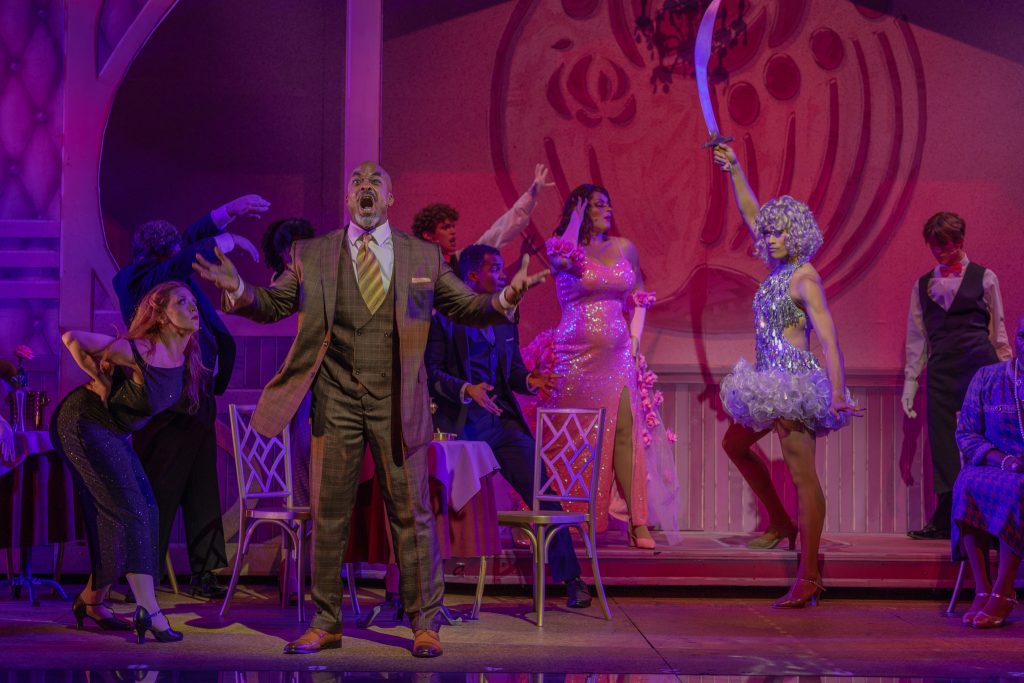
With its thoughtful themes of family, acceptance and tolerance, this warm and wonderful show is not just flashy fluff, but also shines with authenticity..
In a world that doesn’t always value diversity in families, this musical amplifies real family values. After all, love is love is love is love.
The Muny presents “La Cage Aux Folles” from Aug. 8 to 14 nightly at 8:15 p.m. on the outdoor stage in Forest Park. Its runtime is 2 hours and 30 minutes with a 15-minute intermission. With its adult themes and situations, it is considered suitable for adults and teenagers. For more information, visit www.muny.org.
.
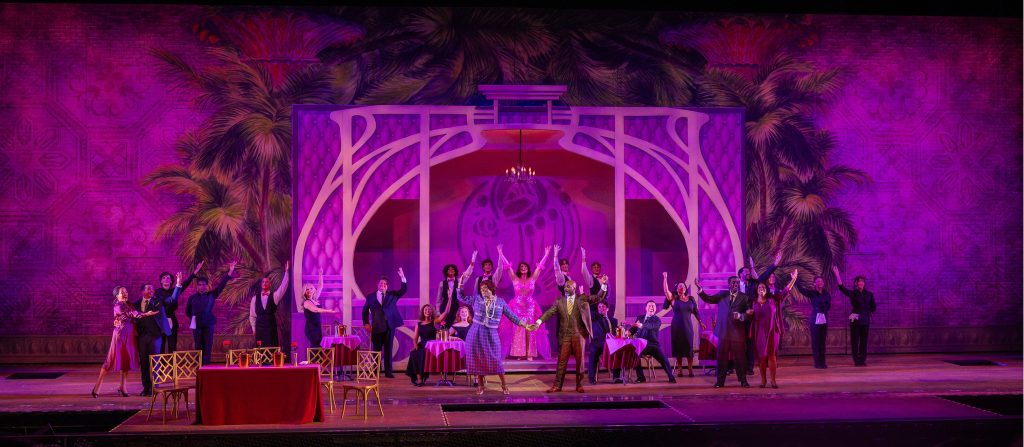

Lynn (Zipfel) Venhaus has had a continuous byline in St. Louis metro region publications since 1978. She writes features and news for Belleville News-Democrat and contributes to St. Louis magazine and other publications.
She is a Rotten Tomatoes-approved film critic, currently reviews films for Webster-Kirkwood Times and KTRS Radio, covers entertainment for PopLifeSTL.com and co-hosts podcast PopLifeSTL.com…Presents.
She is a member of Critics Choice Association, where she serves on the women’s and marketing committees; Alliance of Women Film Journalists; and on the board of the St. Louis Film Critics Association. She is a founding and board member of the St. Louis Theater Circle.
She is retired from teaching journalism/media as an adjunct college instructor.

